Dave Collum's 2025 Year In Review: From Precious Metals To Propaganda's Golden Age
Authored by David B. Collum, Betty R. Miller Professor of Chemistry and Chemical Biology - Cornell University (Email: dbc6@cornell.edu, Twitter: @DavidBCollum),
Every year, David Collum writes a detailed “Year in Review” synopsis (2024, 2023, 2022, 2021, 2020, 2019, 2018) full of keen perspective and plenty of wit. This year’s is no exception, with Dave striking again in his usually poignant and delightfully acerbic way.
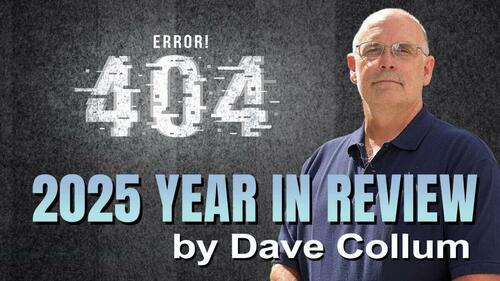
This year's must-read Year in Review is a no-holds-barred exploration of propaganda’s golden age, AI’s rise, epic asset bubbles, precious metals surges, and the unraveling of truth in a technocratic world gone mad.
Click here for a PDF version of this report!
Table of Contents
-
Introduction
-
Podcasts
-
Metals
-
Investing
-
The Complacency Bubble
-
Tucker
-
Conclusion
Introduction
One of the definitions of sanity is the ability to tell real from unreal. Soon we’ll need a new definition.
~ Alvin Toffler, futurist
In the not-so-distant past, we would plan a trip in advance. There was no guarantee that there wouldn’t be mishaps, but our brains were wired in the open mode rather than the closed mode. I am reminded of my son’s road trip with friends to New Hampshire. They found themselves sitting at a dock with their gas gauge near empty at 11:45 PM in mid-December with the GPS instructing them to wait for the ferry…after the sun rises…in the spring. That, of course, is an extreme example of not seeing more than one move ahead.

The moment you realize the world is upside down.
We are now living in a technocracy that is changing too fast to metabolize, what futurist Alvin Toffler back in 1970 referred to as ‘future shock’. We travel through life guided by our metaphorical GPS; we no longer know the complete route to our destination, only the next turn, and it doesn’t always work. My internal GPS device is now randomly rerouting me, constantly flipping to new directions, causing dysfunction the magnitude of which will become clear shortly. Facts do not stay factual. The past is like a Tarantino film where history is rewritten to control the narrative. I can no longer trust my lying eyes. As Bret Weinstein so incisively noted, somebody has intentionally broken all of our fact-checking mechanisms.ref 1 (I adore Bret and his brain.)

Derinkuyu, Turkey, occupied circa 2000 BC
For 16 years I wrote what has been called a Year in Review. It started humbly as a synopsis of my investment returns with a few paragraphs of commentary that were on the top of my mind and shared among a handful of digital friends. Over time, it mutated into a bloated stage-IV growth spanning 250–300 pages summarizing a vast range of topics. I would plunge down rabbit holes, often finding rabbits, but occasionally I would hit Göbekli Teperef 2 or Derinkuyu.ref 3,4 I don’t debunk anything, because debunking implies that you start with a conclusion and set out to prove it. In a now-legendary debate on Joe Rogan’s podcast, Doug Murray argued that we are unqualified to share our views with a big audience unless we are credentialed experts, an argument that was utterly destroyed by uncredentialed comic, Dave Smith.ref 5 Nevertheless, whether I refute or merely offer my interpretation of events, the risk of coming off as an ignorant asshat is quite high or, as some might say, higher than normal.
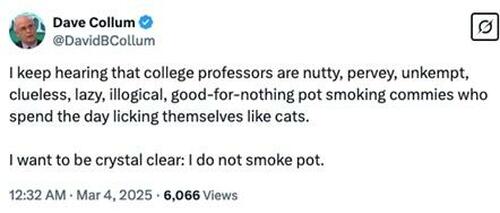
So why do I keep churning these out at the end of each year? What is in it for me? For starters, capturing the year’s events before they escape into the void where memories are lost appeals to me. Also, a half-century of studying chemistry—a fairly complicated subdiscipline of organic chemistry at that—has taught me that you do not have a functional, self-consistent model until you convert it to prose. Writing anneals disjointed thoughts and ideas into a coherent narrative and offers deeper insights that would be missed by simply being a passive observer. I also explicitly pursue topics that I know absolutely nothing about but want to explore through the process of writing—what I call writing my way to wisdom. Writing it once per year gives me time to gather data, ponder its meaning, discard the irrelevant noise, and focus on what motivates me. So I do it for myself, but my inner narcissist grazes on the credits and kudos coming from clicks, eyeballs, and dry humping of my leg while marinating in dopamine.
[Theodore Lowi] was the most insightful Cornell professor I had ever encountered until this “Dave Collum” feed showed up on X!ref 6
~ David Stockman, former Chief Economic Advisor to Ronald Reagan
Unfortunately, I unexpectedly began feeling like a prisoner in a gulag created by this daunting task. You cannot write a Year in Review in March, and projectile vomiting out 250–300 pages in the last couple of months of the year is insane. You need to have your A-game. The autumn writing season is not only rough on me but also on my wife. I am unreachable in my zone, which often leads to outbursts from my wife like, “Are you deaf? OK. I’ll do it myself God dammit,” which leaves me thinking, “What an odd way to start a conversation.”
It’s very pure. It is cheap to produce, and it has to be good for something. I just don’t know what.
~ Bob Moriarty on the generating hardcover YIRs
Many lurking issues came into focus when Bob Moriarty and Jeremy Irwin initiated a project to smack my total body of work—16 annual reviews totalling over 3,000 pages—into a bound anthology. (Bob also gets credit for publishing my first blog ever over 20 years ago under the pseudonym ‘Thomas’.) I had no idea why Bob and Jeremy were doing this, but they were determined to do the heavy lifting, so we began the task. Jeremy gets credit for massive editing and reformatting; Bob gets credit for providing the emotional support.
Try not to fuck up with the next books.
~ Bob Moriarty
While plowing through thousands of pages of proofs, I began to understand what my co-conspirators had intuited. The digital world began changing, imperceivably at first but with increasing acceleration over the last decade. Of course, the early writings seem quaint and naïve as I worked through the basic principles: I largely caught rabbits. But there was something more. I could assemble a jigsaw puzzle—the corner and edge pieces at first—and put together a reasonably coherent picture. The unimaginable or at least unimagined occasionally morphed into the undeniable.
Man has a limited biological capacity for change. When this capacity is overwhelmed, the capacity is in future shock.
~ Alvin Toffler, futurist
Political wonk Mike Benz noted that around 2013 the so-called Deep State—that shadowy group of characters who construct and promulgate narratives for mass consumption (pronouns: they/them)—was losing control of these narratives owing to the speed that information could travel via social media. A decade ago, we had a society-wide shared set of facts. This is no longer true. The puzzle pieces have become increasingly fluid; the undeniable now morphs into the questionable.
People of the future may suffer not from an absence of choice but from a paralyzing surfeit of it. They may turn out to be victims of that peculiarly super-industrial dilemma: overchoice.
~ Alvin Toffler, futurist
The 2024 Year in Review (YIR for short) was subtitled, “What is a fact?”, which expressed my growing frustration. Maybe I am personally running on fumes, but I suspect that my sources that seemed to dependably provide hard facts and hilarious anecdotes have become corrupted. I read articles on topics that should interest me but don’t, leaving me wondering if ChatGPT is creating sterilized narratives void of input from biological beings. AI-generated images were cute at first but lack humanity. Is writing suffering the same fate?
I think our reverence for the truth might have become a bit of a distraction that is preventing us from finding consensus and getting important things done.”ref 7
~ Katherine Maher (NPR CEO)
Although the sociopaths in control of wealth and power cannot keep gnarly details private (…mmm Pizza!), they can flood the zone with so much debris that it is nearly impossible to sort fact from fiction or to even stay focused enough to try. The signal is smothered with noise or what Adam Curtis called in the context of the Soviet Union, “hypernormalization.”ref 8
Propaganda is the executive arm of the invisible government.
~ Edward Bernays, father of modern-era propaganda
The elites grabbed control of mass media, social media, Wikipedia, and the farcically labeled ‘fact checkers’ to ensure that credentialed experts all sing from the same song sheet. We have entered the Golden Age of Propaganda. It is patently obvious to me that 9/11, mass shootings, assassinations (including Charlie Kirk), false flags, climate change, COVID and vaccines, and foreign wars are all a load of propaganda that would make the Godfather of propaganda, Edward Bernays, look like a poultry choker. They drive the manure spreader right into our homes. It is so garish, yet it works every time. Several podcasts describe the distortions created by modern propaganda—the digital world’s newest variant of hypernormalization.ref 9,10 Marc Crispin Millerref 11 and Chase Hughesref 12,13,14 are particularly incisive, but these inoculations will be only partially efficacious.
If something online pisses you off you are witnessing social engineering.ref 15
~ Chase Hughes (@NCIUniversity), an expert in influence, pursuasion, and human behavior.
If the opinion that’s coming out needs people to be silenced, then it is a psyop. If you can’t question it—if you’re supposed to just go along—it’s a psyop.ref 16
~ Chase Hughes
But didn’t the bad dudes—the Cornpops of the World—overplay their hand during COVID? Aren’t we now alert to those bastards’ dirty tricks? Maybe so, or maybe it was intentional. NBA legend Larry Bird would tell his defender what shot he was about to take, take it, drain it, and leave his defender a broken man. We all know JFK was killed by some organized group that is categorically called the CIA: so what? You need not keep a secret but only contain the public’s response. Channeling Larry Bird, Larry Silverstein told us they would pull building seven, they pulled it, and left the entire 9/11 narrative broken. So what? They lie to us. We know they lie to us. They know we know they lie to us. So what? They still give out the mRNA vaccine, support genocides (including yours Bibi), and claim to be the good guys defending democracy. We know they are lies, but so what?
To make a man forget the past, and blind him to the future, is as easy as making him drunk. The impression of invincibility is disaster itself. The stronger the illusion, the greater the fall.ref 17
~ Barbara Tuchman, The March of Folly
The markets offer yet another example. We are in what Jeremy Grantham calls our third and probably most epic asset bubble in only 25 years. We will be shocked for the third time when they rug us of our retirement savings. Bubbles serve a purpose by allowing pent-up cockeyed ideas to be tried. Three in 25 years, however, is not creative destruction but rather creative demolition. Larry Fink tells us his big investment ideas, sells them to us, drains our accounts, and leaves us broke and broken.
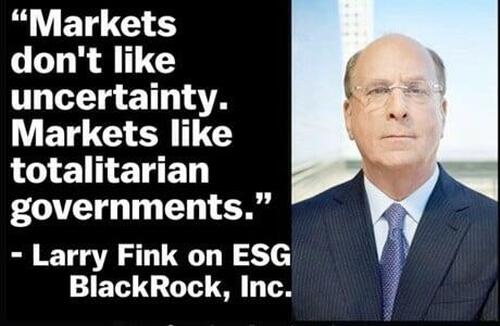
And now we no longer know what is real even if we see it with our lying eyes because of AI. I heard him say it! Are you sure about that? Do you trust Sam Altman? Did he have his coworker whacked?ref 18,19 Is he a genuine sociopath? An AI creation? Either way, the dead eyes speak volumes.

None of this document was written or even edited by AI. Explicit uses of Grok for information or entertaining answers have explicit attribution. Walter Kirn says AI loves em dashes. Well, so do I, so get over it. Experiments in which you recursively use AI to reprocess previous AI-generated results ultimately generate total garbage. Squeegeeing the drippings off the floor of the internet ultimately produces slop. What AI is showing us is why markets act so nuts. Computers are taking cues from other computers recursively with little or no human intervention, producing slop. As an aside, editing by two humans, my brother (Ned, @NedtheBuff) and @DNComply, is greatly appreciated, but don’t blame them for my mind tailings.
Is Valuation Dead In the Age Of AI? “Psychedelic Prices” and Collapsing Economic Coordinationref 20
~ Headline by Be Water (@BeWaterltd)
AI is also training an entire generation to bypass the process of writing. The young are mastering AI to do their homework and write their papers. The AI-Industrial kraken is gonna spend trillions of dollars building environmentally dangerousref 21 data centers filled with hardware that has the life expectancy of a soufflé. They will drive up the cost of energy, commandeer the Wealth of Nations, and likely drain the wealth from passive investors’ index funds. It is sold to us under the auspices of national security, which is Wall Street’s version of selling us a nuclear arms race. Nobody will go to jail despite the obvious frauds already beginning to surface.ref 22,23,24 We will scream holy hell, but so what? It will demoralize us like Larry Bird’s defender until they come up with the next laser pointer for the cats to chase.
Our technological powers increase, but the side effects and potential hazards also escalate.
~ Alvin Toffler, futurist
The Year of Our Lord 2025 feels like a transition, but to what is unclear. Regular readers will recognize from the tenor that I am at a personal fork in the road. I will follow Yogi Berra’s advice and take it. It won’t be obvious at first, but this YIR is also transitional and, in all probability, disappointing for some. That is code for “suck.” That this document exists was by no means a foregone conclusion. I decided to submit nothing several times en route to my destination.
Shawn Ryan: Everything is a lie.
Tucker Carlson: What do you mean by everything?
Shawn: Everything.ref 25
Personal Diary
Never, ever tell anyone about your problems; 90% don’t care. The other 10% are glad you have them.
~ Charlie Munger
My dour mood aside, it was a relatively uneventful year at a personal level compared to some. One could argue that I need an intervention because we got another Boston Terrier puppy, bringing the tally to four Boston’s and a Labrador. We named him Snorri after the Icelandic poet and historian Snorri Sturlusonref 26 or, more appropriately, the fictional dwarven trollslayer, Snorri Nosebiter. I like the flexibility of inventing surnames like “Snorri Floorshitter” or “Snorri Wallpisser.”

My son’s Eli (top) and Snorri (bottom).
There is an inviolable rule among the Collum dog pack: if one barks they must all bark. Wall Street calls this “technical analysis.” A Boston Terrier’s natural habitat is under bed covers. It gets crowded with four, but there is a trick: when it is time to go to bed, ring the doorbell and quickly grab your spot. This is what the Larry Finks of the world do.

I am feeling reflective. Maybe it’s getting a puppy and pondering whether he will outlive me. During my career I raised a family, cooked every dinner, went to every sporting event and concert, and did some heavy lifting in the healthcare department. I head-coached a collegiate sport and assistant-coached another. I published 167 papers—not a huge number, but they were dense—in a discipline that few dared enter owing to its complexity. As an assistant professor I was told it was unlikely I would ever get funded and risked being carried out in a scientific pine box. Well, once I figured out how to write a grant—how to really write a grant—I put up 21 funded Federal grants in a row. At an approximately 20% funding rate, that is a one-in-500,000,000,000,000 probability (100 Nvidias.) I am the only chemist at Cornell to hold all four departmental administrative positions (including department chairmanship). Why am I telling you this? I don’t know. It must be a drop in my serotonin levels.

I wrapped up my research program in 2024. In 2025, I cauterized my 45 years at Cornell by publishing a review of my career through an unusual lens.ref 27 It was three years in the writing. I would dab a few brush strokes here and few there in the way Leonardo painted his paintings.ref 28 I think it is a great document with important messages. It got 500 clicks. For fuck’s sake, I can get 5,000 clicks from an obscure podcast requiring no preparation and 1.5 million on a big one. Is 500 clicks a failure? No. As I said, it is a great document with important messages. Reflecting back on my life and career, my opinion is the one that matters.
I look back on it now, and it all seems so trivial…I spent my life in the toy department of human existence.
~ Howard Cosell, death bed regret
A person very close to me—a family member by proxy—is a world-class harpsichordist. All hell broke loose when he had a stroke. The market value of a debilitated harpsichordist drops precipitously. Of course, the Bank of Dad (BoD) provided quantitative easing, but a GoFundMe analog was set up by the music world that raised over $75,000 to help him with considerable expenses during his recovery. What warmed my heart is that a call to my Twitter followers—generous souls I have never personally met —raised half of the money.ref 29 Michael is playing again and almost fully recovered. Notice the dog…Man’s best friend.

Trigger Warnings
Dave doesn’t care if he comes across as an asshole. He really doesn’t. He’s just trying to get it right.ref 30
~ Cedric Youngelman, The Bitcoin Matrix Podcast and a good friend

Every year I put out trigger warnings about how I am rude, crude, lewd, and loaded with ‘tude, which causes detractors to come unglued. I set a new high water mark this year (vide infra). What seems unfair is how little credit I get for what I don’t say. And I have Tourette’s Syndrome, so fuck off.

Let’s get this straight. Nobody calls a person born with physical or mental abnormalities a retard. It is a term of endearment reserved for your siblings, best friends, and…well let’s stop digging and move along with some trigger warnings.
- I have caveman DNA. If you are already offended, stop reading or stop being a pussy, which is short for pussilanimous.

- If you are a devout democrat, you won’t lose your shit this time around because I have largely ignored you after years of berating. I feel like Jane Goodall. You should spend your precious time getting your shit back together. My generation wore bellbottom jeans, while you soy boys led a movement to cut off your dicks (autopeotomy). Neuropsychologist Oliver Sachs studied a guy who was positive that the leg hanging off his body was not his leg!ref 31 Do you know what they didn’t do? Cut it off. The moral of the story is you do not fuck with your genitals. Well, you know what I meant…whatever. Instead of playing pull my finger and lighting farts, clean up your own act and clean up the DNC while you’re at it. Bring in Damien to do an exorcism for Christ’s sake. The US is a better place with two functional political parties. Even one would be a good start.
assoil
(verb) – an archaic or legal term meaning to absolve or acquit. “I assoil the democrats for their poor performance.”
(noun) – Hair tonic used by Gavin Newsome.
- If you are a devout MAGA, you will be disappointed too. A 2025 YIR statistically weighted to match the news cycle would be 95% about President Trump, but I have no interest in going there even though he is an improvement over President Autopen. I could make the case he is playing multi-dimensional chess or completely boning everything he touches. This debate has engaged millions of self-appointed political experts without my help.

- If you are a devout Zionist, you should stop reading now. I could bitch about my bagel having too much gluten, and you will empty your colon—lose your shit—and call me an antisemite. I don’t need your shit, and, in case you’re wondering, there is a subplot here.

Podcasts

I did my annual trip to Brien Lunden’s New Orleans Investment Conference. The Boom-Bust Panel shared with Peter St. Onge, Jim Iourio, and Jim Bianco focused on the AI bubble while the audience was mesmerized by Peter’s shirt. I also ran a 45-minute workshop that ended three hours later with almost nobody leaving. What the hell topic could do that? Child Trafficking and Geopolitics, of course. The presentations at the meeting are fun and the food is great, but I go to hang out in the green room and chat with old friends and meet some new ones.

I am invited to do a ton of podcasts, presumably owing to an interest in a range of subjects and an irresponsible lack of social filter. They are listed below primarily as an archive but also for the mentally deranged lacking purpose in life who might want to gulp down Adderall and binge a few. The style of the interviewer certainly makes a big difference, and those with three or more of us pick up a distinctly different tone. I benefit from podcasts because they help me refine my thinking much the way a comedian hits the basement comedy shops to refine a schtick. Some warrant additional comment.
I explained why I’ve mostly stepped back from doing my own podcast. “I feel like I don’t have anything of dire importance to say anymore…I feel like the truth is, a lot of what needs to be said has already been said—repeatedly.ref 1
~ Chris Irons (@QTRResearch)
I concurred with Chris—Why do any more podcasts?—and then the next day we recorded one.ref 2 In one of Tom Nelson’s podcasts I give an overview of a talk on climate change and why the dominant narrative is a gigantic grift.ref 3,4 Curiously, that grift is about to end because it stands in the way of the AI hustle. Bill Gates, NASA, and the EPA have said as much.ref 5,6 I participated in a Zerohedge debate on climate change in 2024 and moderated a Brent Johnson–Peter Schiff debate on the consequences of tariffs (2025).ref 7 A prominent podcaster, Adam Taggart, asked for suggested guests.ref 8 Out of 635 replies, some with multiple names, at last check Grok ranked me fourth behind Michael Burry, Rick Rule, and Mark Faber. That was cool.
You can skip the rest of this section. It is largely archival for me, although the graphics may have some value.

- Andy Millette (@theandymillette) of Natural Resource Stocks.ref 9
- Andy Millette (@theandymillette) of Natural Resource Stocks.ref 10
- Andy Schectman (@ASchectman) Little by Little Podcast.ref 11
- Anthony Enciso (@Piggos_T_Desk) of Piggo’s Trading Desk.ref 12
- Anthony Enciso (@Piggos_T_Desk) of Piggo’s Trading Desk.ref 13
- Anthony Fatseas (@AnthonyFatseas) on WTFinance.ref 14
- Anthony Pompliano (@APompliano).ref 15
- Ben Kelleran (@BR_Kelleran) of Kontrarian Korner.ref 16
- Ben Kelleran (@BR_Kelleran) of Kontrarian Korner.ref 17
- Ben Kelleran (@BR_Kelleran) of Kontrarian Korner.ref 18
- Cedric Youngelman (@CedYoungelman) and Paul Tarantino of The Bitcoin Matrix cameo.ref 19
- Cedric Youngelman (@CedYoungelman) and Paul Tarantino of The Bitcoin Matrix with three other hodlers.ref 20

- Cedric Youngelman (@CedYoungelman) of The Bitcoin Matrix.ref 21
- Cedric Youngelman (@CedYoungelman) of The Bitcoin Matrix.ref 22
- Cedric Youngelman (@CedYoungelman) of The Bitcoin Matrix.ref 23
- Chris Irons (@QTRResearch).ref 24
- Chris Martenson (@chrismartenson) of Peak Prosperity.ref 25
- Chris Martenson (@chrismartenson) of Peak Prosperity.ref 26
- Christian E. White of Dark Truths & Hidden Powers.ref 27
- Christian E. White of Dark Truths & Hidden Powers.ref 28
- Daniel Ayoubi @CapitalCosm podcast.ref 29
- Daniela Cambone-Taub (@DanielaCambone) of ITM Trading.ref 30
- Darrell Thomas (@MoneyLevelsShow) of the Money Levels Showref 31
- Doctors for Covid Ethics (finance).ref 32
- Eric Rice (@EA_Rice) of The Rice Report.ref 33
- Gary Bohm (@GaryBohm5) of Metals and Miners podcast.ref 34
- Ivan Bayoukhi of Wall Street Silver (@WallStreetSilv).ref 35
- Jason Burack (@JasonEBurack) on WallStForMainSt.ref 36
- Jesse Day (@jessebday) of VRIC Media (Part 1ref 37 and Part 2ref 38)
- Jesse Day (@jessebday) of VRIC Media.ref 39,40
- Jon Forrest Little (@ThePickaxe_Ag) of Silver Academy.ref 41
- Kai Hoffmann (@JrMiningGuy) at KAMVEST and Soar Financial.ref 42
- Kai Hoffmann (@JrMiningGuy) at KAMVEST and Soar Financial.ref 43
- Lucijan Valkovic (@capnek123) of Triangle Investor.ref 44
- Marty Bent (@MartyBent) on Tales from the Crypt.ref 45,46
- Marty Bent (@MartyBent) on Tales from the Crypt with Rudy Havenstein (@RudyHavenstein).ref 47,48

- Mike Farris (@CoffeeandaMike) of Coffee and a Mike.ref 49
- Mike Farris (@CoffeeandaMike) of Coffee and a Mike with @AaronRDay.ref 50
- Mike Farris (@CoffeeandaMike) of Coffee and a Mike with @AaronRDay.ref 51
- Mike Farris (@CoffeeandaMike) of Coffee and a Mike with Alex Krainer (@NakedHedgie).ref 52
- Mike Farris (@CoffeeandaMike) of Coffee and a Mike with James Kunstler (@jhkunstler).ref 53
- Mike Farris (@CoffeeandaMike) of Coffee and a Mike with James Kunstler (@jhkunstler).ref 54
- Mike Farris (@CoffeeandaMike) of Coffee and a Mike with James Kunstler (@jhkunstler).ref 55
- Mike Farris (@CoffeeandaMike) of Coffee and a Mike with Tom Luongo (@TFL1728) and James Kunstler (@jhkunstler).ref 56
- Mike Farris (@CoffeeandaMike) of Coffee and a Mike with Matt Smith (@Mattpheus).ref 57,58
- Mike Farris (@CoffeeandaMike) of Coffee and a Mike with Melody Wright (@m3_melody).ref 59
- Mike Farris (@CoffeeandaMike) of Coffee and a Mike with Melody Wright (@m3_melody).ref 60
- Mike Farris (@CoffeeandaMike) of Coffee and a Mike with Steve Hanke (@Steve_Hanke).ref 61
- Natalie Brunell (@@natbrunell).ref 62
- Robbie Bernstein (@RobbietheFire).ref 63,64
- Robert Smallbone (@contrarianrob88) on The Contrarian Capitalist Podcast.ref 65
- Shane Hazel (@SaneTHazel), Mike Holbart (@theemikehobart), and Jordan (@OpLibertas) on
- Bitcoin Veterans Podcast.ref 66
- Shaun Newman Podcast (@SNewmanPodcast).ref 67
- Shaun Newman Podcast (@SNewmanPodcast).ref 68
- Shaun Newman Podcast (@SNewmanPodcast).ref 69
- Susan Lustick radio interview.ref 70
- Tom Luongo (@TFL1728) of Gold Goats ‘n Guns.ref 71
- Tom Nelson @TomANelson) of the Tom Nelson podcast.ref 72,73

- Tommy Carrigan (@tommys_podcast).ref 74,75
- Tommy Carrigan (@tommys_podcast).ref 76
- Tommy Carrigan (@tommys_podcast).ref 77
- Tommy Carrigan (@tommys_podcast) with Tom Luongo (@TFL1728) and James Kunstler (@jhkunstler).ref 78
- Tommy Carrigan (@tommys_podcast) with Tom Luongo (@TFL1728) and James Kunstler (@jhkunstler).ref 79
- Tommy Carrigan (@tommys_podcast) with Tom Luongo (@TFL1728) and James Kunstler (@jhkunstler).ref 80
- Tommy Carrigan (@tommys_podcast) with Tom Luongo (@TFL1728) and James Kunstler (@jhkunstler).ref 81
- Tommy Carrigan (@tommys_podcast) with Tom Luongo (@TFL1728) and James Kunstler (@jhkunstler).ref 82
- Tommy Carrigan (@tommys_podcast) with Tom Luongo (@TFL1728) and James Kunstler (@jhkunstler).ref 83
- Tommy Carrigan (@tommys_podcast) with Tom Luongo (@TFL1728) and James Kunstler (@jhkunstler).ref xx84
- Tracy Suchart (@chigrl) and Anthony Crudele (@AnthonyCrudele) on NinjaTrader Live.ref 85
- Tucker Carlson (@TuckerCarlson) of Tucker Carlson Network.ref 86
- Twitter spaces with @RudyHavenstein (lost link)ref 87
- Wealthion (@Wealthion) with James Connor (@JamesConnor1999) of Bloor Street Capital.ref 88
- ZeroHedge: Moderator for Peter Schiff (@PeterSchiff)-Brent Johnson (@SantiagoAuFund) debate.ref 89,90

Metals
Everyone on X has suddenly become a Platinum Group Metals expert.
~ Tony Greer, Editor of The Morning Navigator
For the first time in my investing experience the big three precious metals—silver, gold, and platinum—or what one might call the “metalverse”—earned serious attention.

The above-ground supply data offer a solid foundation. The above-ground gold supplies dwarf those of silver because of both geologic rarity and the relentless consumption of silver for industrial purposes. Platinum is both rare as hell and an industrial metal. This section is for generalists. The specific investment implications are found in the subsequent ‘Investing’ section.
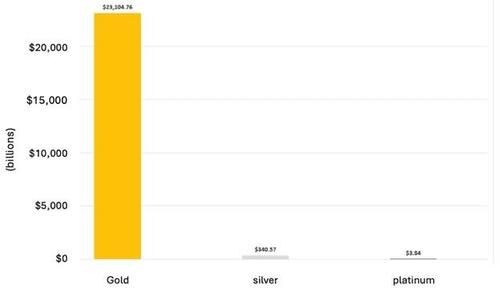
They (gold investors) want everybody to be so scared they run to a cave with gold. Caves might be a better investment than gold. At least they’re not producing new caves all the time.
~ Warren Buffett
Gold
Despite a wild year for gold bugs, the long-term performance of gold has not received adequate respect. Lyn Alden noted that, despite a legendary performance by Berkshire Hathaway (BRKA) over eons and Buffett’s pithy verbal smack downs, gold’s performance has matched BRKA over the preceding 27 years.ref 1 As noted by both Jim Reid of Deutchbankref 2 and Eric Peters, CIO of One River Asset Management,ref 3 gold’s >1200% return over the last 25 years manhandles the >700% return on the S&P and >800% return on the Nasdaq.

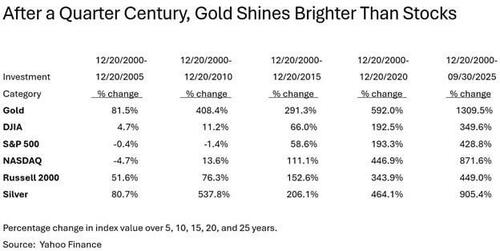
Panning back, gold has gained approximately 8% annualized since it resumed trading in 1971. This compares reasonably well with the 10% compound annualized S&P total return—the CAGR total return—especially if you extract fees and taxes on the dividends stemming from the S&P booty. Since the time of ancient Rome it is said that an ounce of gold has bought you a new suit, but what the hell is the going rate of a toga? A better metric is that an ounce of gold supposedly bought you a month of manual labor, which hasn’t changed. A modern-era $20-an-hour pay for a 40-hr work week gets you $4000 gold, which means gold’s 2000-year compounded annual return is zero. Before you declare that sucks and call me a boomer, let me point out that a back-of-the-envelope calculation, which naturally includes some bold approximations, of the growth in the global economy over that same window is <1%. The obvious conclusion is that humanity produces wealth at nearly the same rate that it consumes, depreciates, or destroys it. Makes sense. If you let the infrastructure of the technological world decay without constant input, within 25 years it would regress back to Biblical-era valuation. We have compounded knowledge rather than wealth over the millennia.

Money (noun) – A medium that can be exchanged for goods and services and is used as a measure of their values on the market.
Now let’s look at gold in the short term, which will likely piss off the most libertarian gold bugs. The new leg in the rising price of gold has everybody denominating the price of other assets in gold. The rallying cry is that “gold is money, it is the dollar that changes!” That is simply not true in the short term. Everything I buy is denominated in dollars, not gold. Gold has doubled in 15 months benchmarked to the US dollar; is that all dollar depreciation? Not a chance. The prices of goods and services in the short term much more tightly track the dollar than gold, at least for the time being. If the price of gold collapses 50% next year—a decidedly deflationary event for the dollar benchmarked to gold—will the cost of my dollar-denominated groceries drop by half? If you wish to make a case for buying or selling gold, have a ball. But in case you hadn’t noticed, gold is far too volatile to use as a benchmark to measure the value of other assets. It’s a cute parlor trick, but the intrinsic volatility of gold makes it a chart crime when used as a benchmark for goods and assets.
This is a defining question for the US in the years ahead: How long can America afford to sit out the global rush for gold? US gold reserves are now at 90-year lows, while the rest of the world has pushed their holdings to near 50-year highs. At one point, America held over 50% of global gold reserves. Today? Just 20%. My view: It’s only a matter of time before US policymakers are forced to rethink this stance.
~ Tavi Costa
The current leg of gold’s run appears to correlate with President Autopen’s weaponizing of the dollar against the Rooskies in 2022, which may prove to be a catastrophic geopolitical move because every other country got the memo too: Joe’s geopolitical FAFO (fuck around/find out) will play out in the banking system and forex markets. The BRICs, which started out as a cute acronym for Brazil, Russia, India, and China as prominent emerging markets, have become an alliance that now includes several dozen countries including some serious OPEC oil producers. During a period in which the US had maxed out the demonization of Russia, the BRICs held their annual meeting in Moscow.ref 4 This is a big step toward a multi-polar world that risks US and dollar hegemony.
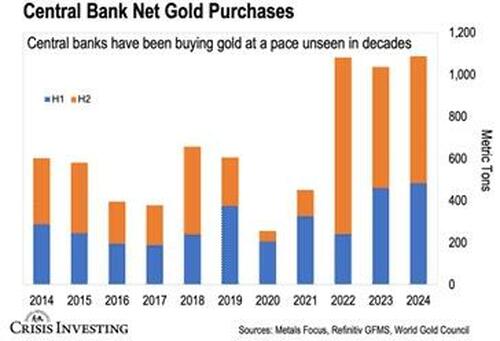
Poland certainly got the memo (even accounting for the criminal y-axis lacking zero at the origin)…
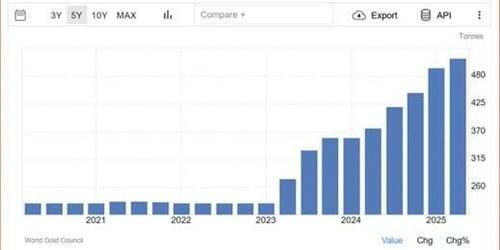
Even Zimbabwe got the memo…

The marked rise in gold this year caused angst in the global futures markets where the SOP (standard operating procedure) seems to involve lots of trades and precious few real transfers of physical gold. So-called ‘eligible’ gold at the Comex is gold that has the requisite properties required for delivery to a futures contract such as 100-ounce and kilogram bars but is not available for delivery. Only ‘registered’ gold is available for delivery. The difference between the two became importantref 5 as gold began moving furiously between Zurich, New York, London, and China to satisfy calls for delivery. The US tariffs were a “self-imposed embargo” on the metal,ref 6 accelerating shipments to New York before tariffs were enforced.ref 7,8 The Trump administration read blitz, called an audible, and declared that 39% tariffs on Swiss gold would be trimmed to 15%.ref 9 Persistent and lengthy delays in delivery kept blood pressures up while retail investors rejoiced in the price-jacking chaos.
Critically, the gold originally shipped from London or Switzerland to New York may have ended up in Asia at the completion of its journey. Shortagesref 10 resulting from sovereign hoarding exacerbated the tightness. Gold went into a protracted period of ‘backwardation’, which is a third-trimester linguistic abortion describing how the price for physical gold in the present exceeded the price of gold in the futures market. I am told this is bullish. As gold went into backwardation, the price was steadily in upwardation, as time steadily moved into forwardation while the net worth of those short gold went into downwardation. (OK. I’ll STFU now.)


For years, retail investors squealed about how the paper gold market dwarfs the physical market by as much as 300x. Gold had become trading sardines. Shorting an equity supposedly requires borrowing shares within 24 hours to keep the number of shares constant. Naked shorting where no such borrow occurs is illegal on Wall Street (kinda like hookers and blow) because it operationally counterfeits new shares. By contrast, the gold futures market allows you to sell fictional gold without borrowing the metal, thereby producing an unlimited number of tons of gold in the cloud. It seemed like a day would come when that gigantic wad of shorts would need to be covered, but the day that the cloud gold would rain on the shorts’ parade always seemed to elude the free market. Investors are salivating over the possibility that the day has finally arrived. Time will tell.

There was also a surge in organic demand for the metal stemming from Russia, China, and the several dozen BRICs countries who appear to be positioning for a shift in reserve currency from the dollar (petrodollar) to something backed by gold. Such a shift would be a multi-standard-deviation historic event. It would amount to a cold war version of WWIII fought on the battlefields of finance, but history shows hot wars can arrive with little warning.
One of the chief reasons to be bullish on gold and negative on the dollar is that there is so little deliverable gold available.ref 11
~ Chris Whalen, Whalen Global Advisors and author of The Institutional Risk Analyst
July 1st also witnessed the arrival of the Basel III banking regulations, which classify gold as a Tier 1 asset at full rather than discounted value that can be used as collateral in their core capital reserves.ref 12 I must confess that I am doing a Milli Vanilli on this shit because, from my perspective, the banks are never bashful about levering up to become too-big-to-fail (Club Bailout). I guess allowing gold to boost their legitimate capital reserves means they don’t have to lie as much.
The public mania around stablecoins is the latest evidence that humans are incapable of making rational decisions when they are part of a crowd.ref 13
~ Chris Whalen, Whalen Global Advisors and author of The Institutional Risk Analyst
Government-sanctioned stablecoins appear to be another new source of demand for gold as backing for stablecoins. Again, this crap baffles me. My understanding is that Tether backs the stable coins dollar-for-dollar with US treasuries and then pockets the proceeds to invest in more entertaining assets like gold, private equity, NFTs, Beanie Babies, and Hunter Biden artwork. Secretary of the Treasury Bessent seems to like this idea because it generates demand for US debt, but one can’t help but wonder if the guys running Tether might get too far over their skis, causing that dollar-for-dollar backing to vaporize. I will not be surprised if this plot turns fugly.

How high can gold go? Well, the obvious answer is “the moon”. We could ask the credentialed experts because they are the only ones qualified to give horribly incorrect answers. Early in the year, UBS raised its gold price target to $3,500 while Goldman Sachs raised theirs to $3,700. Well those guys sure met my expectations.
More people believe Elvis is still alive than own gold in the US.
~ Gerald McMillan, some bloke at TheHumbleAdvisory.com

Let’s look at historical metrics to assess the price change required to regress to the means. Henry Smith, Director and Investment Manager, The Keep Fund Ltd estimated that gold holdings account for only 1% of portfolios globally and 0.5% in US portfolios.ref 14 He notes your grandfather carried a “10% minimum in gold.” Smith projects that five-digit gold and three-digit silver are in our future. My arithmetic says that a 0.5%-to-10% conversion requires a 20-fold gain relative to other assets. If we optimistically assume a total collapse in those other assets by –75%, that still requires a fivefold gain in the price of gold to $20,000 to get you to the target.

If Gundlach is right, then you can fire up that Coke-Mentos rocket because we are headed to the moon, baby! I think we will have to wait a bit, however, because the ultimate contra-indicator threw a couple of knuckle balls, leaving investors dazed and confused…
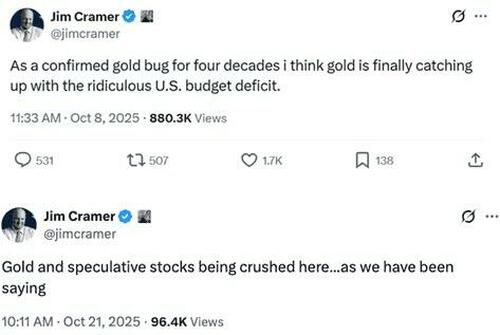
While I am being a punk-assed bitch, I might as well pick another fight. This past year witnessed repeated discussions of “repricing” gold. I get the Tier 1 asset idea, but there soon emerged some serious bullshit about governments repricing their gold to pay off their debts without actually selling any gold. The chatter seemed to hinge (or unhinge) on the idea that by declaring gold to be worth $4,000 an ounce instead of $42 an ounce we could declare that we really aren’t in debt that much. Let’s start with the obvious: 8,700 tons of gold is only $1.2 trillion at today’s spot price, which seems like a lot of cash until you compare it to our soon-to-be $40 trillion debt and >$200 trillion in unfunded liabilities. The highly respected Judy Shelton chimed in by suggesting a gold-backed 50-year treasury. In this context what does gold-backed even mean? FFS-I will promise to back anything 50 years from now. The dollar is currently lead-backed (allocated lead stored in hundreds of US Military bases).
But then somebody at the Federal Reserve got high as fuck and suggested that we simply declare gold is worth a serious buttload of dollars per ounce and pay off our debts with that repriced asset.ref 15,16 This is the money shot showing how it supposedly was implemented in other banana republics:
The central bank’s annual reports for these years state that they sold portions of their gold reserves and then immediately repurchased this gold at the same price to convert unrealized valuation gains on their gold reserves into realized profits…the revaluation account can be shifted to other parts of the balance sheet to generate funds…book these now-realized profits as income and use them to offset other losses incurred by the bank.
~ Colin Weiss, Board of Governors of the Federal Reserve System
I should add that if you price gold at $50,000 an ounce, I will gladly sell you mine, but I am not sure that’s how the free market works. Why not resurrect the idea of minting a handful of trillion-dollar platinum coins—“Krugmans”ref 17—and hand them to our creditors? Or how about this: put a big-assed price tag on all our Federal land and sell it to ourselves?

Well, the author finished the Fed paper with a sober statement describing when Germany pondered the idea:
Opposition to the revaluation plan emerged from both the Bundesbank and the broader German public, and their opposition highlights that revaluations may not be viewed as prudent fiscal management.
Before moving along to silver, let’s look at a couple of cute gold-backed anecdotes. With refinement of metal detectors, gold hoards are discovered frequently, often of interest to ancient historians.
- Hikers in the Czech mountains scooped up a $340,000, but this was a 20th-century hoard of little historical importance.ref 18 They turned it over to the Museum of Eastern Bohemia, which probably used it to buy a lot of brewskis and sauerkraut.

- About once a year outlandish reports of gold discoveries designed to push the price of gold surface from the cubicles at Goldman. This year, Uganda claimed to discover a 31-million-ton deposit of gold worth $12 trillion.ref 19 The influence on the price of gold was inadequate to pay for those illegal hookers and blow.
- Elon and The Donald declared that they would audit Fort Knox to see if we had any gold. It had an “Al Capone’s Vault” feel given that a true audit would take years to identify ownership. On a Rogan podcast they took a more high-tech approach illustrating the limitless potential of AI:
Elon and Joe Rogan to Elon’s newest AI: Is there gold in Fort Knox?
AI: What. Am I a fucking conspiracy theorist?ref 20
Silver
The twin sister of gold this year is the bicurious metal silver. It has industrial demand in the new tech, every electronic device, and solar panels.ref yy As an investment vehicle outpaced gold, doing the whole physical squeeze and backwardation thingie. There were days of stunning price moves in which nearly a billion ounces of silver were sold in the early morning hours to hammer silver for a couple bucks.ref 21 These late-night bear raids are common, but they were special this year. India’s largest silver refiner ran out of silver.ref 22 Silver’s 300:1 paper:physical ratio argues that there may come a day of reckoning when futures traders demanding delivery will trigger severe supply shocks and epic price spikes (read: blow up the up the Comex). This could occur soon since the Basel III Accord is projected to include silver as a tier 1 asset starting in 2027, elevating silver to a monetary and banking role that hasn’t been seen in decades.ref 23

Some traders suggest that the approximate 100:1 gold:silver ratio will finally regress to a historical value of 16:1. I have yet to see a persuasive argument as to why this would be true beyond just investor sentiment.

There are, however, millennia of historical support…

The black swan for silver would be if Larry Silverstein decides to “pull it”, and we witness the price of silver drop at freefall speeds into the basement.
Platinum
The fundamental case for platinum is potentially profound. For starters, it is 30 times rarer than gold and was and still is priced at the discount table of Walmart.

Seventy percent of the world’s platinum comes from South African mines, which is not the most stable region of the world. The British Geological Survey predicts a significant drop in supplies amid collapsing Capex (capital expenditures) by platinum miners.ref 24 If South Africa becomes a failed state, the miners are likely to follow the Marxists down the drain, while a supply constriction should cause the metal to ride the SpaceX rocket. Another 10% of mining supply comes from Russia. Although I am sure they will be happy to sell it, the metal could head East, not West. The US hasn’t exactly positioned itself high up on Russia’s list of favorite nations. Maybe platinum will be part of a bilateral trade deal between Trump and Putin when they resolve the Ukraine issues over the dead bodies of every European leader.
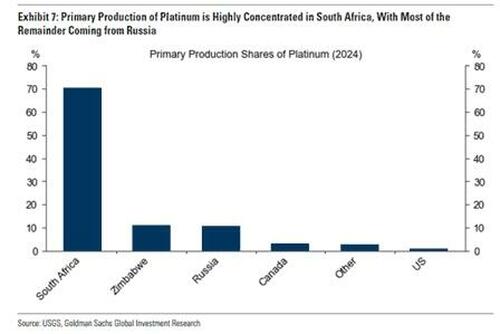
Estimates of supplies and demand are sketchy, but the World Platinum Investment Council (WPIC)ref 25 put the above-ground supplies at 5 million ounces in 2022, 3.5 million ounces in 2023, 3.0 million ounces in 2024, and a projected 2.5 million ounces in 2025.ref 26 That, dear reader, is a trend that could be your friend. There is an estimated four months of above-ground supply to satisfy global demand. At the $900 per ounce flatlined price, the total above-ground supply could be swallowed up by one crazy hedge fund manager with <$2.5 billion bucks in their pocket. With prices already elevating, a June estimate put the value of the above-ground platinum at $3.84 billion.ref 27
I decided to pry some answers out of Grok, which coincidentally rhymes with “crock”:
Me: Assuming production of platinum stays constant, at the current rate of platinum demand how long will it take for the above-ground supplies to be depleted?
Grok: (after providing lots of useful details)… Assuming constant platinum production and demand at 2024–2025 levels, above-ground platinum supplies (2,160 koz in 2025) would be depleted in approximately 2.2 years (around early 2027), based on an annual deficit of ~966–992 koz. However, this estimate is sensitive to changes in demand (e.g., green hydrogen growth or EV adoption), supply disruptions, and potential underestimation of stocks. Price increases or supply adjustments could extend this timeline.ref 28
All these projections assume this ballsy whackjob fails to mine platinum from asteroids.ref 29
The demand from the investment world seems like it must be in its infancy in that at current prices the above-ground supply is, as noted above, an estimated $4 billion. I have no way of knowing what serious investor enthusiasm could do to the price, but it is the only precious metal that has avoided a meme phase. It is currently parked 30% below its 2008 all-time high. China and, soon thereafter, Russia announced the opening of a futures market in platinum in early January.ref 30 In Q1 of 2025 jewelry sales in China were up +300% YoY,ref 31 which some attribute to Chinese demand in the face of soaring gold prices.
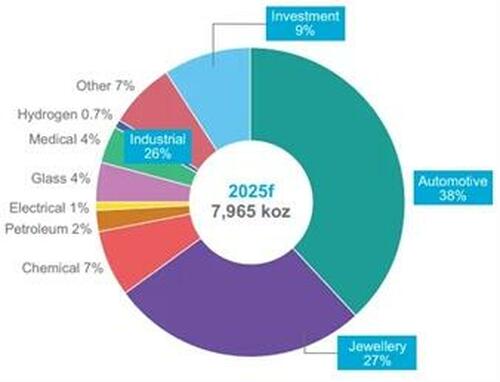
WPIC data for platinum demand.ref 32
The industrial demand story is compelling. The WPIC claims that the metal is relatively insensitive to supply and demand. This could be construed as saying it was flat as a pancake for a decade. It also suggests, however, that the consumers of platinum will pay whatever price – whatever it takes – to get their paws on the metal. Would Ford stop producing Ford F150s if platinum doubled or even tripled? The EV story also seems to be faltering, leaving hybrids as the optimal technology. Because the catalytic converters in hybrids run infrequently (colder), hybrids use more platinum than the standard internal combustion engine vehicles.ref 33,34 As China realizes that the citizens are choking on the fumes and dying from cardiovascular and respiratory problems, their consumption of platinum for catalytic converters is guesstimated to rise fivefold in the coming years.ref 35

“He owns precious metals.”
Investing

Here is some rock-solid investment advice that you can bank: do not take investment advice from an organic chemist. With that said, I must admit it was a pretty good year for the stopped clock. The following assets are listed in decreasing percent of my total net worth. Dividends are not included, only changes in share price. The individual percentages are the 2025 returns as of 12/18/25. Comments follow.
Positions above 10 percent of my net worth
- Fixed income: +4%
- Gold bullion: +65%
- House: –1%
Positions accounting for 1.0–10 percent of my net worth
- Silver bullion: +130%
- General equities (indexed): +14%
- Goehring & Rozencwajg (GRHIX): +48%
- Platinum (PPLT): +41% (108% yoy)
- Fidelity Select Energy (FSENX): +9%
- Agnico Eagle Mines (AEM): +112%
- Fidelity Select Gold Portfolio (FSAGX): +139%
Positions accounting for 0.10–1.0 percent of my net worth
- Pan American Silver (PAAS): +151%
- Fidelity Natural Resources Fund (FNARX): +25%
- British American Tobacco (BTI): +58%
- Altria (MO): +13%
- Rio Tinto (RIO): 32%
- Palm Valley Capital Fund (PVCMX): +5%
- Jaguar Mining (JAGGF): +239%
- Anglo American Platinum (ANGPY): +167%
- Cameco (CCJ): +67%
Positions accounting for <0.10 percent of my net worth
- Wesdome Gold (WDOFF): 91%
- Impala Platinum (IMPUY): +209%
- Sibanye Stillwater Limited (SBSW): 331%
- Harmony Gold (HMY): +153%
- iShares MSCI Brazil ETF (EWZ): +37%
- Suncor Energy (SU): +21%
- Prophase Labs (PRPH): –85%

Buy! Buy! Buy!
I suffer from the “Boomer’s Dilemma”: a position in an asset that is large enough to be consequential to my financial future seems like too damned much money. I am training myself to think in percentages, but social media and podcast comments sections relentlessly remind me that boomers are intellectually deficient. You want to know how deficient we are? I asked Google AI for the definition of a boomer looking for the specific age range and got an answer that was not on my Bingo card:
In slang, a “boomer” is a term for an older person who is perceived as close-minded, out of touch, or resistant to change, particularly concerning technology and social issues. The phrase is most famously used in the comeback “OK, Boomer,” which dismisses someone’s opinion as outdated and not worth arguing with. While originally referring to the Baby Boomer generation, the slang term can be used for anyone who holds these “boomer-like” attitudes, regardless of their actual age.
~ Google AI
Refocus Dave. The table of assets suggests progress in resolving Boomer’s Dilemma is slow. Most of those positions could go to zero instantaneously without necessarily forcing my assets in the red for the day. However, I am convinced that risk assets will make boomers suffer at some point and now is no time to be sizing anything boldly. My deep-seated fears of uninvestable markets going forward are laid out in lurid detail in the following chapter.

The investment choices within my portfolio change imperceptibly year-over-year and often minimally decade-over-decade except for those years when I do something big like swapping bonds for equities in post-crash ’87, equities for gold in ’99, began ramping into energy hard in ’01, and sit on my ass with cash and buying nothing in ‘09. Following a highly credible nominal total gain in net worth of +14% in 2024 my 2025 total return came at a robust +33% gain held back by plodding gains of ~4% in fixed income and no gains in real estate (my house). For those who scoff at the heavy weighting in fixed income, I remind you that when ugly turns fugly that position will save my bacon while yours may be getting pan-fried. Cash equivalents are what the pros call “dry powder”, which you have to acquire and hoard at the tops to be locked and loaded at the bottoms. I treat my mortgage-free house as an asset because it hangs off a 100-foot cliff looking west over Cayuga Lake and ties up three times the capital than my fully adequate farmhouse sold for. The reported loss comes from a Zestimate,TM which, according to Mitch Vexler,ref 1 is likely bloated to squeeze taxes out of me.
At this stage, cash is king. So 95% of my money in the funds are in cash.ref 2
~ Mark Mobius
My total return was eroded slightly by a negative savings—spending above my means. (If I were on Wall Street, I would do a write-down and pretend like it didn’t happen.) By wrapping up my research group, I forfeited 25% of normal salary that was partially offset by the onset of social security. (I didn’t even notice I would be getting social security until mid-2024.) There was a relentless run on the Bank of Dad (BoD) as my largest customer (my wife) drained accounts for a kitchen and bathroom renovation in an Adirondack cabin. Warning to my readers: the fastest route to bankruptcy is to be married to a grandmother. The BoD did some angel investing in my oldest son’s new startup company, which any parent knows is the most subprime of debt since it is in default from day one. My younger son’s Italian 1735 Carlo Antonio Testore violin financed by the BoD in 2024 needed restoration and a much better bow in 2025 and always needs some help as a starving musician in Boston. My savings rate, which stayed in the black even during my children’s college years, was –5% of my gross salary this year.

I just never tire of Sydney Sweeney’s stinkeye and good jeans. The bottom half of the table of assets represents my wish list. I often buy insignificant positions to serve as Post-its. I will keep adding new Post-Its to my portfolio for that day when sizing bigly makes sense. Do I wish I had bought gobs of gold miners? You betcha, but mining is a tough business, and dry powder must stay dry. Recall that as gold rose from $256 to peak at $1900 and then camped out at $1200—a >300% gain—the high-flying miners gave it all back. You have to be excerebrated to touch gold miners.
In ’09 my failure to buy aggressively despite Grantham’s well-timed urgings was out of greed, not fear; I was cash rich (>50%) and confident the markets had another halving—’The Great Halvening’. I was ready to dodge dead cats hurtling back to Earth, but the truly unimaginable $30 trillion of central bank bailouts preempted Newtonian physics.
Our biggest failure is our failure to see patterns.
~ Marilyn Ferguson
I have a new strategy in case opportunity knocks again in my investable lifetime, which is getting pretty short since old men should be heading to safety, not to battle. In 2020, I bought some energy funds at Fidelity but sized them way too conservatively. The sector seems potentially cheap now, but a secular bear market will make them cheaper (See Valuations for why). Energy (Dogs of the Doha) and other industrial commodity-based assets are likely to be the recipients of my active flows at some point, but even though energy equities seem fairly priced you’ve gotta wonder which direction energy moves from here. Maybe I will wait for that squiggle to tell me to buy more.
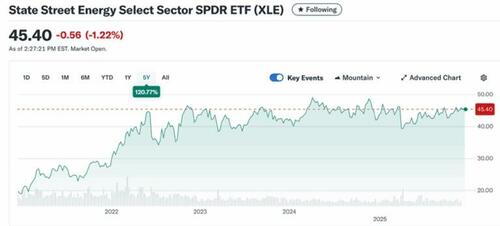
PPRH was a swing and a miss. Last year I predicted PRPH “will probably go to zero.” That may be my most accurate call ever. I am also tempted to buy a Post-It-sized position in Bitcoin as hodler repellent: “OK. I own some, now STFU and leave me alone!”

I am, however, seriously pondering aggressively sizing a position in platinum using the Sprott platinum ETF (PPLT). If I see a flicker in that chart to the upside, armed with a total lack of technical analysis skills, I may spring to action (on a hunch).ref 3
~ Me, 2024 YIR
Platinum
The potentially big story in my future is platinum based on fundamentals as delineated in the Metals section. I had been watching platinum wondering why it was flatlining for years—The Great Flattening. (I can do this trick all day long.) Platinum has been as dead as disco. This time last year I had a couple of ounces of platinum. Period. That is not to say I wasn’t watching it like a hawk. I had taken a small position in the platinum miners that looked dirt cheap but managed to get much cheaper. They obviously have rallied back, but I shifted my focus to the metal itself. Two years ago, Mitch Feierstein ripped my ear off on the par five sixteenth hole at Cornell about why I must go long platinum bullion while I was busy shanking my irons and yipping my chips. I ignored him but dropped three paragraphs last year on why he might be dead right.
Whether you buy physical platinum and palladium, an exchange-traded fund [ETF] or the trust, if you think the price of the metal will rise, buy the metal.ref 4
~ Rick Rule
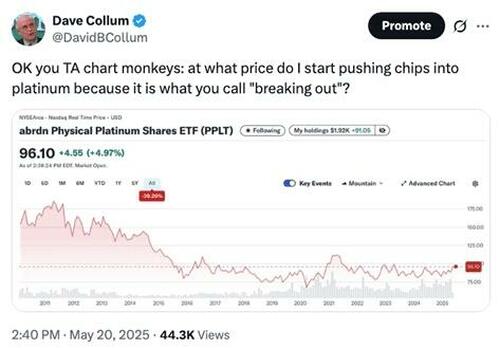
After consulting with several prominent technical analysts (chart monkeys), I bought a Post-It of PPLT on 1/21/25 and then waited patiently for a pulse—a squiggle on the chart—to tell me that we were about to leave the horse latitudes. And there it was, right in front of my lying eyes. In late May PPLT began to move in high-volume trades.

I bought eight notably larger chunks from 5/30 to 10/14 in rapid succession by my standards. (Errata: while editing this section I just bought another slug of PPLT at $159.) The 41% overall gain resulting from averaging up was small in comparison to the 108% rise in PPLT over the year, but I was able to grow the position—work towards resolving the Boomer’s Dilemma—with minimal pain while staying in the green. My PPLT position is not fully sized yet, but it has risen to be my 7th largest holding. My good friend Peter Boockvar nailed the platinum story and probably sized it better.
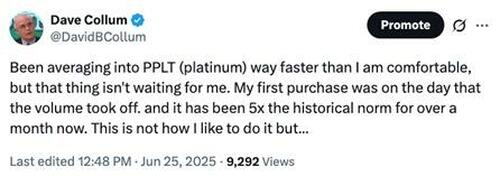
We foresee continued demand for platinum to the extent that we see sustained deficits, and therefore continued eradication of excess surface inventory.ref 5
~ Nico Muller, CEO of Impala in February, 2025 while pondering mine closures
Some saw this run coming. In April, Rick Rule made a case for platinum right before the breakout. He has such sway in the metals world that he might have triggered it.ref 6 Lincoln Samuelson at Contrary Investors said that “Platinum is the most mispriced asset on Earth,” noting that South Africa was pondering taxes and quotas on platinum exports.ref 7 Great call Lincoln, but how was the play? Tariff fears were credited with the speculative buying as platinum was pulled from warehouses in London and Zurich and shoved into the NY Mercantile Exchange and in Chinese exchanges with record flows in July. Yet, those same fears seemed to have little influence on the price after its initial run.ref 8 Curiously, the initial spike in price came in the face of heavy ETF redemptions as there was a scramble (possibly from Asia) for the physical metal.ref 9 According to Bob Coleman, the demand for physical metal was manifesting an EFP (Exchange-For-Physical) spread collapse to negative $12 in June (big and persistent “backwardation.”)ref 10 Soon investors began piling into the ETFs driving flows back into the ETFs (or so they claim). As I am wrapping up this section, it was announced that India’s pension regulator has widened its investment options for funds. The Pension Fund Regulatory and Development Authority (PFRDA), will now permit gold, silver, and other commodities to diversify holdings.ref 11

The Complacency Bubble
You asked me what I learned. I didn’t learn anything. I already knew that I wasn’t supposed to do that. I was just an emotional basket case and couldn’t help myself. So, maybe I learned not to do it again. but I already knew that.
~ Stan Druckenmiller on losing $3 billion on dot-com stocks in six weeks
Every major decision that I make in life I send through a simple filter: if it goes terribly wrong, will I forgive myself? This filter and being a stubborn boomer are two cornerstones of my investing philosophy, which is decidedly valuation-driven with a profound aversion to chasing price.
There is no greater impotence in all the world like knowing you are right and that the wave of the world is wrong, yet the wave crashes upon you.
~ Norman Mailer
2015: A Retrospective Look
By proofing sixteen previous YIRsref 1 I had occasion to pound through some decidedly bearish forecasts. To say that I got it wrong—the most broken of clocks—would be a grotesque understatement. Just look at responses on my Twitter feed and any comment section on my podcasts: everybody knows I have been predicting profound problems for years. My reasoning, however, still seems indisputable even in retrospect. Using my 2015 YIR to provide a decade for comparison, I made a compelling case that we were, once again, staring into the abyss. I did so with plots and data, of course. But I was also in good company including some legends. I normally wouldn’t do retrospectives on my analyses. But to understand the present I am going to bludgeon you with some 2015-vintage quotes from the legends juxtaposed with a few in which “legend” is only on their curriculum vitae and in their own minds. What is noticeable is that their dire warnings were all centered on horrific monetary policy. I called it a “bond caldera”—a bond bubble so large you can see it from space—and how market participants and society would pay dearly. From my 2015 YIRref 2,3,4…
Equities would be the toughest to exit … it’s like a 5-lane highway going in and a goat trail coming out.
~ Kyle Bass, President of Hayman Capital (2015)
I am looking at a bubble that is almost sure to pop at some time, and I don’t know when it’s going to happen, but I know it’s going to happen … I don’t think it’s at all ridiculous to think of a selloff like we saw in 2008.
~ Julian Robertson, former Chairman and Chief Executive Officer of Tiger Management Corporation (2015)
The world’s central banks can’t save us anymore. The trade now is to hold as much cash as possible.
~ Nikhil Srinivasan, Chief Investment Officer for a European insurer (2015)
The persistence of extraordinary policy accommodation in a financial system flooded with liquidity poses a great danger.
~ Stephen Roach, former Director of Morgan Stanley (2015)
The Fed’s quantitative easing lowering the real rate of interest has been responsible for the rise in P/E multiples … and when rates normalize, that will reverse.
~ Alan Greenspan, some guy on CNBC (2015)
Our monetary policy is so much more reckless and so much more aggressively pushing the people in this room and everybody else out the risk curve that we’re doubling down on the same policy that really put us there.
~ Stanley Druckenmiller, former Chairman and President of Duquesne Capital (2015)
We are now in the terminal stages of QE, during which the practical limitations of this fatuous and discredited policy are being revealed.
~ Tim Price, PFP Group (2015)
I am pretty horrified by the global quantitative floodgates that have been opened since the 2008 Great Recession. Once an emergency measure of dubious effect, it is now a never-ending stream of confetti money being thrown around the world to inflate asset prices. QE has now become the policy variable of first resort. Personally I think this will all end very badly.
~ Albert Edwards, Societe Generale (2015)
They don’t understand the treacherous path they are going down…Those guys who run these companies are borrowing money very cheaply. They are buying back stock or, even worse, making stupid takeovers.
~ Carl Icahn, corporate raider (2015)
The Fed’s unconventional monetary policies have also created dangerous risks to the financial sector and the economy as a whole.
~ Martin Feldstein, Harvard University (2015)
The cost I was worried about was the longer-term cost of unraveling all of this.
~ Charles Plosser, former President of the Philadelphia Fed (2015)
Get off zero and get off quick…Near-term pain? Yes. Long-term gain? Almost certainly. Get off zero now!
~ Bill Gross, Janus Funds (2015)
Asset inflation is roaring, but it is sectoral and skewed. Consumer inflation is understated, and thus growth is overstated. Employment data [are] misleading. This combination of factors means that ordinary citizens are not doing well, but the owners of high-end everything are doing just fine, with few concerns for the middle-class people who know things are not ‘all right,’ but cannot put their finger on why.
~ Paul Singer, Elliott Management Corporation (2015)
Federal Reserve [actions] will have disastrous long-term consequences … In an era of peak debt, the only thing zero interest rates achieves is create an enormous incentive for Wall Street to gamble more and more recklessly.
~ David Stockman, Director of Management and Budget under President Reagan (2015)
And aiming for 2 percent inflation every year means that after a decade prices are more than 25 percent higher, and the price level doubles every generation. That is not price stability, yet they call it price stability. I just do not understand central banks wanting a little inflation.
~ Paul Volcker, former Fed Chairman (2015)
The market is going to say ‘oh my god, we’re so far behind the curve’ and force an adjustment that is going to be wrenching … [the Fed] has almost no credibility … the market is going to take the Fed and the Treasury curve to task in a very painful way.
~ Lawrence Lindsey, former of member of Fed’s Board of Governors Governors (2015)
The truly unique power of a central bank, after all, is the power to create money, and ultimately the power to create is the power to destroy.
~ Paul Volcker, former Chair of the FOMC
All global financials markets are a shell game right now.
~ Bill Gross, Janus Funds, founder of PIMCO (2015)
An addiction to QE could ultimately mean that the second great depression was only postponed, not avoided altogether.
~ Stephen King, Chief Economist at HSBC (2015)
We have zero growth, zero inflation, and zero hope … The systemic failure of policymakers to understand and reverse the worst monetary experiment in history has created a situation where we need a deep crisis to shake off the mantle of this nothingness reality. (2015)
~ Steen Jacobsen, Chief Economist at Saxo Bank (2015)
The global economy is rife with imbalances that cannot be fixed under the present international monetary (non)system.
~ William R. White, Chairman of the OECD (2015)
We are going to be changing monetary policy from the most extremely expansionary we’ve been able to do in all of history to an extremely expansionary monetary policy.
~ Stanley Fisher, Fed Vice Chairman (2015)
What worries me is how totally lazy investors have gotten, totally dependent on the Federal Reserve, and I find this to be a precarious situation.
~ Richard Fisher, former President and CEO of Dallas Federal Reserve (2015)
Fed chatter is akin to reading the lyrics of a James Brown song—don’t make no sense.
~ Grant Williams, RealVisionTV.com and Vulpes Investment Management (2015)
The Fed is screwed.
~ Boockvar, Chief Market Analyst of the Lindsey Group (2015)
The long-term consequences of global QE are likely to permanently impair living standards for generations to come while creating a false illusion of reviving prosperity.
~ Scott Minerd, Guggenheim’s Chief Investment Officer (2015)
Our belief is that the global economy and financial system are in a kind of artificial stupor…we assume that a very surprising and scary environment lies in wait.
~ Paul Singer, Founder and CEO of Elliott Asset Management (2015)
Capitalism has been propped up every time it’s about to go through one of the cyclical creative destruction phases…it’s the fault of the authorities for not letting cycles naturally evolve.
~ Jim Reid, Managing Director at Deutsche Bank (2015)
I think that another generation will look back and say ‘how could you have made that mistake all over again? How could you have failed to understand Hayek’s notion of the fatal conceit, that central planners can’t do better than the dispersed knowledge and signals of free market processes?’
~ Mark Spitznagel, author of The Dao of Capital and founder of Universa Investments (2015)
There was no shortage of stupid statements from the elite. Here is just a couple…
There is a whole generation of people who don’t remember inflation. They don’t know what it is, and so I think inflation is a non-existent threat.
~ Alice Rivlin, former Vice Chair of the Fed’s Board of Governors, making my brain hurt (2015)
Inflation is hopefully giving little signs of moving up in the right direction.
~ Christine Lagarde, Director, IMF (2015)
How much has Twitter contributed to productivity? Seems like it does.
~ James Bullard, President of the St. Louis Fed (2015)
The economy has improved considerably; that’s why we need to continue the extraordinary measures we’ve been implementing.
~ Janet Yellen, Chair of the FOMC
And the most horrifically outlandish statements of them all…
A similarly confused criticism often heard is that the Fed is somehow distorting financial markets.
~ Ben Bernanke, former head of the Las Vegas Fed (2015)
By 2016, the squeals about zero-interest-rate policy (ZIRP) and negative-interest-rate policy (NIRP) had reached gale-force winds and the fears had not abated…
The unpalatable truth is that the banking model is broken. The days of generating gobs of cash from “socially useless” financial engineering…are over.
~ Mark Gilbert, Bloomberg (2016)
This will be the year that ‘gravity’ will overwhelm the central bank policies.
~ Stephen Jen, co-founder of SLJ Macro Partners (2016)
Like it or not, that means we are in line for another stomach-turning round on the
global economy’s wild ride.
~ Simon Johnson, MIT Professor and former IMF Chief Economist (2016)
Markets don’t have a purpose anymore—they just reflect whatever central planners want them to. Why wouldn’t it lead to the biggest collapse? My strategy doesn’t require that I’m right about the likelihood of that scenario. Logic dictates to me that it’s inevitable.
~ Mark Spitznagel, Universa Investments (2016)
All pension plans everywhere in the world are being destroyed. Trust funds, insurance companies, endowments—they are all being destroyed.
~ Jim Rogers on NIRP and central bank policies (2016)
Negative and low interest rates around the world are crushing savers, and those policies are going to become the biggest crisis globally. We have become too dependent on central bankers.
~ Larry Fink, Chairman and CEO of BlackRock (2016)
The capital asset pricing model is being broken — smashed to pieces — as a matter of deliberate policy.
~ Robin Griffiths, Chief Technical Strategist at ECU and previously at HSBC (2016)
I don’t think a single trader can tell you what the appropriate price of an asset he buys is, if you take out all this central bank intervention.
~ Axel Weber, former head of the Bundesbank (2016)
Even as far back as 2015, countless people in the know recognized that the banking system had metastasized into a flesh-eating bacterium. This was no way to run a banking cartel, and Wall Street had mutated into a lawless Mexican border town. This carefully orchestrated mess produced a Cambrian explosion of bad ideas and immaculate interventions. The interest rates had been dropped too low for too long too many times, and now society at large was poised to pay the price as the old mossbacks in 2015 had warned. The global bond markets were shackled by strict Sharia Law (0% interest). Investors would soon be scrawling their names on their arms with Sharpies to be identified at the morgue. The streets would soon be filled with cannibalistic Syrian rebels. Sorry, I get carried away. On a serious note, what happened next—at the very moment the financial system had painted itself into a corner—is a triumph of reckless monetary policy.
We futurists have a magic button. We follow every statement about a failed forecast with ‘yet.’
~ Alvin Toffler
2015–2025: A Decade of Gains
2015 had us tee’d up for a real shank both economically and in the markets. What happened next…blows…my…mind. Table 1 shows the ten years of prospective equity returns. I used Grok sprinkled with minor rounding, but they were manually spot-checked at reliable sources:ref 5,6
Table 1. Ten-year returns of major indices.

That is certainly not what those legends of finance in the bygone era of 2015 would have foreseen while staring into the abyss.
Almost anywhere you look—from the popularity of gambling and novel forms of retail investing to soaring crypto prices and the electorate’s choice of president—America is embracing risk.
~ The Economist
Correcting for inflation using the sclerotic CPI that I ripped into last yearref 7 or the more credible M2-money supply give very different results as shown in the Table 1. The plot below shows a 16x reduction in a century of returns with a CPI-based inflation correction. (It’s actually not that useful of a plot because the corrected returns are too buried in the baseline.) Don’t forget: you have to correct for annual fees and taxes in Table 1! The 10-year gains are firmly grounded on the inflation delusion, but the real returns still exceed 4%, which was the upper limit of sustainable gains estimated by Buffett. (The Buffett link is now broken—What are the odds, eh?—but the iconic article is available archivally.)ref 8

If you buy the idea that M2 is the best way to correct for inflation given the relatively wretched alternatives, you are not gonna like Ron Griess’sref 9 plot showing a century of S&P returns with and without inflation correction. For you channel cats, I have taken the liberty of adding the requisite lower bound (in red) to the inflation-corrected data. If valuations were to drop to the bottom of the channel, one cannot rule out a triple-digit S&P. Most with limited Overton Windows will assert that such a drop is not imaginable, but there is overwhelming evidence that many will ignore overwhelming evidence. The economic and societal damage of a sub-1000 S&P is equally unimaginable.
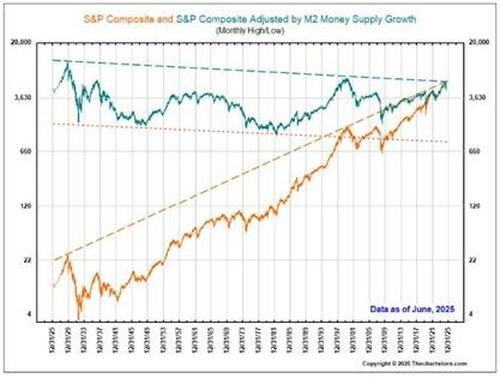
Ron Griess has provided me with an alternative view by including dividends: his chart puts the total inflation-adjusted total return over the last 100 years at 3.77% annualized, which is within an error bar of Buffett’s 4% target. But, as a broken clock, I must reiterate that you now must subtract taxes and fees, which would likely bring the return in the 2% zone.

How we pulled off any gains over the last ten years leaves me gobsmacked. It is easily shown that the tech sector did the heavy lifting as the plots below make glaringly clear.


Let’s dig into the Mag 7—the seven tech stocks that have accounted for a major percentage of the ten-year gains in the indices. Table 2 shows the 10-year gains in revenues, market prices, and market caps of the Mag 7 as well as a few others to round out the top ten. I use market cap instead of share price to account for changes in share counts owing to share buybacks and option-based compensation. What is missing is some serious destruction inflicted on their balance sheets to pull off pump-and-dump buyback schemes. The numbers are approximate because of minor variations in start and end points and variations from sources, but the message is clear.
Table 2. Ten-year returns of the Magnificent Seven.

And some honorary members for laughs that happen to round out the top ten largest companies in the S&P….

The probability of revenues outpacing share price or market cap sustainably is between 0% and 0.0%. Suffering from boredom and internet addiction, I occasionally post such revenue-to-price comparisons on Twitter. When I did it for Dell, I got a curious response:

Michael was either taking a break while planning a $6 billion donation to the Federal government,ref 10 which left a few of us scratching our heads, or he too suffers from boredom and internet addiction. Nonetheless, his point was that Dell started trading publicly in 2018.
Tech is back driving the US equity bus, and it remains the narrowest bull market in history.ref 11
~ Michael Hartnett, Chief Investment Strategist at Bank of America, before telling investors to ride the rip
How the hell did these markets defy the gravitational pull of mean regression? Margin debt correlates with the price increases since 2015, but causality is unclear. Maybe price pulls the margin debt, not vice versa.

Margin debt superimposed on the Wilshire 5000 (Yardeni)
Total global debt also provides liquidity to push up the prices of all assets, but the rise in the plot below is not significantly different compared with previous eras.ref 12 (Beware of the misdemeanor chart-crime owing to the non-zero y-axis origin.)

You can scream from the top of your lungs—earnings are going to be a miss, the CEO is sleeping with Martians, right?—it really doesn’t matter what you say. At the end of the day the non-fundamental traders are the only ones that are actually attracting incremental capital right now.ref 13
~ Mike Green, Chief Strategist Simplify Asset Management
Michael Green—the GOAT of passive investing analysis—has laid out the impacts and risks of passive investing. I thought it was a relatively simple story; it is not. Here are a few links to Michael Green’s work.ref 14,15,16,17,18 The ideas herein come almost exclusively from Michael’s work, but I am culpable for the paraphrasing and associated fuckups. The idea is so simple: hand every month’s allocation savings to your Vanguard’s S&P Index fund or any one of a bazillion clones and then forget about itpas. It has worked brilliantly since it first began in the mid 1990s. Here are some underappreciated consequences of the passive strategy.
-
The flows into the indices are non-linearly distributed: the most expensive, highest market cap stocks are allocated a disproportionately large share of the funds while the smallest cap stocks the smallest share. This propels your portfolio returns upwards because the fliers are more heavily weighted. Mike Mulligan’s Steam Shovel offers a literary metaphor. A side effect is “market narrowing” where the large caps are increasingly dominant as noted above. Why care? You’re making money!
-
The formal ETF and index funds are now estimated to be 25–30% of the market, but an unmeasurably large number of active managers are closet indexers to exploit and avoid humiliation of being beaten by the passive-driven rise while collecting fees.
-
Green estimates that each passive dollar pushed into passive funds boosts the overall market cap $8-10 and the mega-cap Mag 7 $80-100. Fees are reduced because there is no call for fundamental analysis even if there is a desperate need for it. The masses are buying the flows not the fundamentals.
-
The markets are increasingly inelastic—unresponsive to fundamentals like earnings, geopolitics, employment, the economy, and investor sentiment. Eugene Fama’s Efficient Market Hypothesis has been destroyed.
-
Short sellers and their quest to short stocks of corporations run by miscreants have no influence. Worse yet, the Passive Borg or what Green calls the Giant Mindless Robot consumes them. Pure short sellers like Jim Chanos are gone.
-
Market volatility has plummeted. It is no longer a barometer of the economy or corporate health. Good news is good news. Bad news is good news. Dips are soon bought. All that matters is the flows, and they have been positive and increasing for three decades.
-
Elevated values mean retirees-in-training need to save less, allowing them to boost corporate earnings by consuming. This drives up equity prices further.
It is undeniable that U.S. equities today are at least as overvalued as they were [in 2000], if not even more so…Dismissing the similarities between then and now by saying “this time is different” is to fail to learn the important lessons taught by the history of the Dotcom Bust. One key lesson is that “the price you pay determines your rate of return.”ref 19
~ Jesse Felder
Current Valuations
I routinely monitor several dozen valuation metrics, and a few new ones surface every year. I will be selective here to spare you the noise, but others not shown tell the same story. Here are a few that are notable in their utility and capacity to foreshadow future returns. Given that almost all valuation metrics involve dividing the inflation-sensitive market price by an inflation-sensitive benchmark inflation naturally cancels. I have not yet found a metric that accounts for taxes and fees (although Vanguard talks about fees). Both are important but too variable and situationally dependent to include. On the off chance you think you have no fees because you are an indexer, you are assuming that Wall Street is a not-for-profit organization. I am pretty sure those boys in the cubicles are paying for the four Bs—babes, bets, booze, and blow—with cash that somehow comes from you.
American retail investors are all in, buying at an unusually aggressive pace this year. Roughly half of US household wealth is now invested in stocks—breaking the record set during the dotcom bubble of 2000.ref 20
~ Ruchir Sharma, former Morgan Stanley analyst and current author (see “Books”)
Price-to-book value is an old standby metric. When a stock is dirt cheap, the price-to-book ratio of the indexes will drop to and even below unity. It is currently sitting above 5 for the S&P 500. Maybe modern stocks don’t need book value, but this graphic overshould be unnerving…
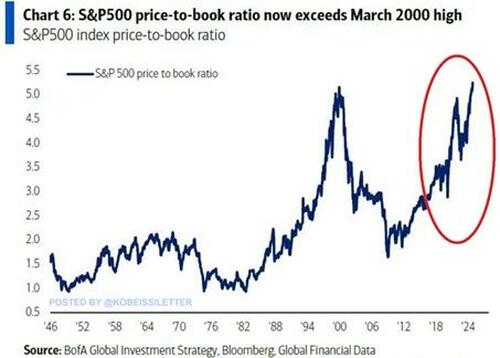
The next plot shows the price-to-sales ratio of the S&P 500.ref 21 It is precisely 3x (200%) off the median value over the last 30 years, and the last three decades were unusual (vida infra).

The current level of valuations is the highest in U.S. history, easily exceeding both the 1929 and 2000 extremes….even if we assume that current record profit margins are permanent, valuations still rival the most extreme levels in history.ref 22
~ John Hussman, Founder of Hussman Funds
Hussman displays the median price-to-revenue ratios of the S&P segmenting the market caps into the median (green), the smallest (red), and the largest (purple).ref 23
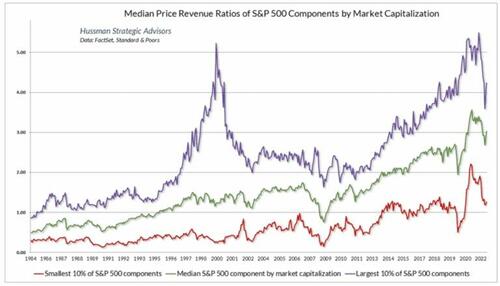
This chart is long in the tooth (2022), but it reveals that removing the mega-cap stocks hides the tech/dot-com bubble of 2000. I find this surprising. It also reveals, however, that the current bubble is not just a meta-tech–AI bubble.
When you get a major capex boom focused on physical tech assets, like the fiber and Internet buildout in the late ’90s, it significantly boosts reported earnings, even if the underlying returns aren’t there.
~ Jim Chanos
The folks with a fondness for “total return”, which includes the dividends, can relax because there’s “no ‘F’ in dividends” (say it fast), which is a valuation metric in its own right…

Here is the crowd-favorite Buffett indicator—the inflation-corrected price to GDP—for the entire US market. What you will notice is that the Creative Planners took the liberty of adding trend lines with an upwardly curving channel. My suspicion is that this implicitly sustainable trend obscures the ugly reality that valuations left orbit decades ago.
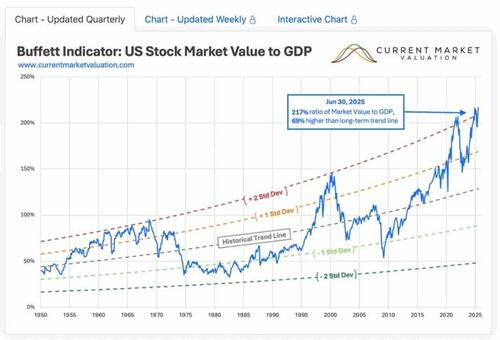
This plot also raises several questions.
- What happened in 1994? The 2024 YIR pinpointed 1994 as the year that escape velocity was attained and every valuation metric left the channel, but I lacked a convincing model to explain it.ref 24 Mike Green, the King of Passive Investing Analysis, says that in 1994 regulations preventing passive investors from using margin accounts and futures contracts were lifted, which allowed them to more efficiently track the market.ref 25,26 We’ll return to the resultant surge in passive investing below.
Overvaluation is appreciation pulled forward.
~ John Hussman
- If the upwardly curving trend is legitimate for some reason, is it sustainable in perpetuity? I think that is, quite literally, impossible. Infinitely rising share price? Of course. To infinity and beyond. Valuation rising in perpetuity? Never.
Mainstream economics is replete with ideas that ‘everyone knows’ to be true but that are actually arrant nonsense.
~ Jeremy Rudd, Economist, Board of Governors of the Federal Reserve System, 2021
- Why would there be any trend leading to the present day rather than just a wobbling of the price-to-GDP in a horizontal channel that regresses to and through the mean? The standard answer I get is that the S&P has become increasingly global. Ergo, using the US GDP progressively underestimates the expanding global contribution to the S&P earnings. Well, I checked and found that data from the Apollo Academy showing S&P revenues from overseas have increased from 35% to 41% over the last two decades.ref 27 The graphic depiction below leaves me unwilling to call a 5% expansion a trend let alone a gale-force tailwind.
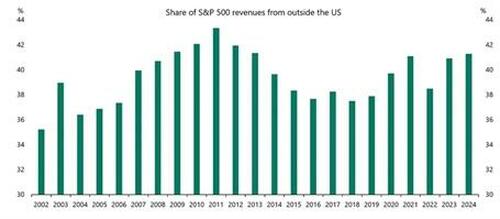
When I queried Grok about the percentage of the S&P revenues that came from abroad in 1990 and 2024, it gave me an even more muted estimate with nuance:
The increase from roughly 20-25% in 1990 to 28% in 2024 reflects decades of globalization, though the growth is less dramatic than might be expected due to currency fluctuations (like a strong U.S. dollar in 2024) and varying sector exposures. For instance, tech companies, which have higher international revenue shares (e.g., 59% for the IT sector), have grown in index weight, influencing the overall percentage.
I’m keen on long-term plots that include data predating the last half-century. Here is the S&P price-to-earnings ratio from 1880. I’m careful to use trailing earnings since forward earnings are Wall Street and corporate fabrications.ref 28 The horizontal line is the mean valuation of 15 for the 110 years from 1880–1990 with an affiliated cash flow of 6–7%. Helen Keller could see that the last 30 years represent a departure from the historical trend. The current value of 30 is 2x the mean with an affiliated cash flow of 3–4%. You might note that the harrowing bungee jump during the Great Financial Crisis (GFC) brought the index back to a decidedly generic average valuation at the bottom and only briefly. It’s amazing what $30 trillion interventions will do to stimulate investors’ animal spirits.

To be ignorant of what occurred before you were born is to remain always a child.
~ Cicero
I also like the Case-Shiller PE (CAPE) with the 10-year smoothed earnings. The horizontal line is still 15 for the 110 years from 1880 to 1990 — smoothing doesn’t change the value calculated from the regular PE. We are currently parked near 40, which has an affiliated cash flow of 2.5%. Yet again, the GFC momentarily brought the S&P back to a historically average valuation. The plunge could have and probably should have been much worse. That would have “corrected” the valuation problem, but those central bankers started molesting barnyard animals with their iatrogenic monetary policy.
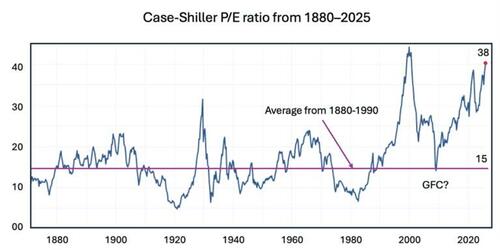
A blended average of several valuation metrics for the US stock market is at a record high in data going back over 100 years.ref 29
~ Simon White, financial strategist at Bloomberg
Composite valuations have the appeal of combining several (usually 3–4) metrics into one. Here are several examples that have a nearly identical message.

Lower inflation, which allowed for lower interest rates and activist monetary policy to intervene during even the slightest sign of market stress, encouraged investors to place ever higher multiples on top of growing margins. This has resulted in the greatest degree of overvaluation in the history of the US stock market.ref 30
~ Jesse Felder, The Felder Report
Jesse Felder’s composite going back to 1950 shows the current bubble dwarfing the epic bubbles from the past, each of which preceded bleak ten-year prospective returns.
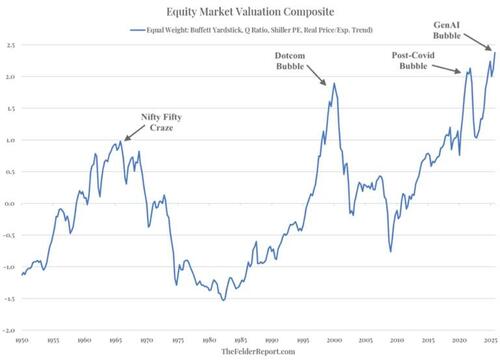
The stock market could get cut in half tomorrow and still be overvalued.
~ Stephanie Pomboy, MacroMavens

The following is the Hussman valuation metric, which is proprietary and corrects for profit margins and other arcane stuff that flies over my head. It is still an ugly impressionist depiction.
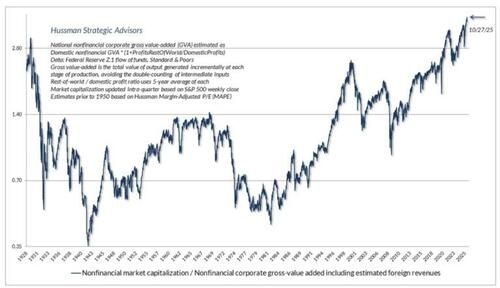
Today’s equity market is significantly more overvalued than it was [in 1973]—twice or three times more overvalued, in fact.ref 31
~ Mark Hulbert, MarketWatch
Mark Hulbert offers a compact view of our current overvaluation by comparing nine valuation metrics to those that preceded the exceedingly painful period for equities in the 1970s:
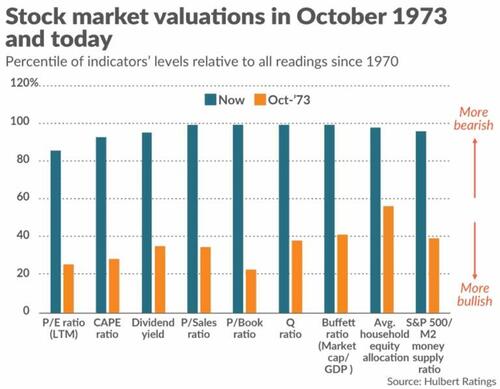
I analyzed 56 major bubbles from 1600-2025. The brutal truth: average loss of 85.63%. But since 2008, we’ve seen an unprecedented parade of bubbles – each following the same devastating pattern. Here’s the complete inventory of financial destruction…The brutal lesson from 400 years of data: When bubbles burst, they take NO prisoners. 48% of bubbles = 90%+ losses (near-total wipeout) 76% of bubbles = 80%+ losses (devastating). Only 24% had “moderate” <80% losses.ref 32
~ Joseph Barbuto, @TheELongWave
The chart below compares the current bubble to epic bubbles of the past. I hasten to add that the current bubble is perched on the bloated carcasses of private equity, commercial and residential real estate, and massive and varied debt (see below), which is why this one is often called the “everything bubble.” Michael Oliver calls it the biggest bubble ever but “more diffuse and multi-dimensional.”ref 33

Here is a self-entertaining use of social media. While in a particularly pensive and bearish mood, I tweeted the bear case based on valuations and admonished the sell-side clowns that traffic in equities for urging investors to stay in no matter what to avoid the catastrophic effects of missing the ten best days. Here is the tweet:ref 34

DogePadre (@DogePadre0717) asked Grokref 35 “Is this post factually correct?” and got the following answer that I have only lightly reformatted to optimize readability:
-
Dave Collum claims markets are at 200% over historical valuation, referencing metrics like the CAPE ratio, which he later mentions yields a 2.5% return. The CAPE (Cyclically Adjusted Price-to-Earnings) ratio, as of April 2025, isn’t directly provided, but historical data shows it often signals overvaluation above 30. In March 2021, the CAPE was around 37, per web data, and given market trends, a 2.5% yield aligns with an overvalued CAPE of 40, supporting his claim.
-
His assertion that overvalued markets always revert to the mean is backed by historical precedent. Web data on mean reversion confirms that assets deviating significantly from their historical average—like a Z-score of 4—tend to correct, as seen in past bear markets like 1929, 1987, and 2000–2003.
-
Collum’s reference to the 2000–2003 bear market, where the Nasdaq saw its 13 largest rallies yet still dropped 80%, is factually correct. Web data confirms the Nasdaq fell over 80% from March 2000 to October 2002, with high volatility and sharp rallies, as bear markets often exhibit.
-
His statement that “you cannot inflate your way out of overvaluation” holds true in a valuation context. Inflation affects both the numerator (stock prices) and denominator (earnings) of valuation ratios like CAPE, leaving the ratio largely unchanged, as he explains in a reply with an inflation-adjusted chart.
-
The claim that no overvalued market in history has failed to return to “cheap” is mostly accurate but nuanced. While markets often revert—e.g., post-1929, post-2000—Japan’s Nikkei, overvalued in 1989, still hasn’t returned to its peak 35 years later, showing exceptions exist. [Highlighting is mine and entertaining.]
-
Collum’s bearish stance aligns with economic indicators in 2025. Rising U.S. debt ($37 trillion, per a reply) and potential currency crises, as another user notes, mirror conditions in emerging markets or Weimar Germany, where stock markets rose nominally but fell in real terms due to currency devaluation.
-
His warning about missing the “biggest days” in the market is supported by data. Fidelity’s research often highlights that missing the best days—typically during volatile bear markets—can shield investors from larger losses, as seen in the Nasdaq’s 2000–2003 period.
That was pretty cool.
I think we’re at the cusp of a bear market in both stocks and bonds that will last up to thirty years…the central banks are all acting in unison, so once this bubble pricks it’s going to be pretty terrible.
~ Milton Berg, CEO and founder of MB Advisors (2016)
I wonder what Milton Berg is thinking now. Is he worried about a 40- or 50-year bear market or relieved that he was wrong? My favorite of all the plots—my plot from hell—is the historical chart of the inflation-adjusted S&P 500 obtained from Ron Griess of TheChartStore.ref 36 One often asks how long it takes to recover from owning the peak, which is usually about 20 years. (You can check for yourself.) What I like to ask is how long it takes to go from the first peak to the last trough with the same inflation-adjusted value. How long did you tread water (Noah)? This is an entertaining exercise with individual assets too. Those red arrows I’ve added represent periods of zero capital gains that are 40–75 years long. If the pattern continues, that last red arrow starting in 2000 should end at a trough in the 2040–2075 window at an inflation-adjusted capital gain of zero. Many of you readers will be dead by then.
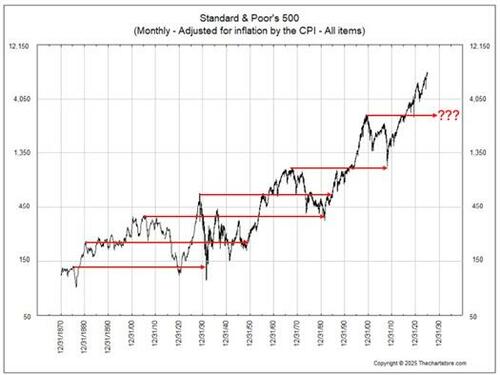
The moral of the story is that owning overvalued markets is risky, and owning an epic top will require a closed casket.
We are going to have a bear market that will be the worst of your lifetime.
~ Jimmy Rogers
Forty Years of Recency Bias
If you are predicting long-term returns don’t show me a chart that goes back four years, fourteen years, or even forty years. We have been in an epic secular bull market since 1981 that wasn’t Reagan’s doing or any particular path we charted. We were about to enter a period of great prosperity and equity gains because of a slew of profound tailwinds:
-
The 1981 market valuations were the lowest in US history. You could not give equities away. Equity analysts were playing solitaire at their desks.
-
A secular credit cycle was about to begin with long-term interest rates in the high teens. As Buffett said in 1999,ref 37 the change in long-term rates is everything. Extended periods of dropping long-term rates are great for risk assets. Those who say low rates are bullish are wrong and possibly lying. Once rates are low—near zero is low—the tailwind of dropping rates will inevitably become a headwind of rising rates.
-
Globalization was on the rise. The Soviet Union and every other God-forsaken place were desperately groping for prosperity by selling natural resources.
-
China was pulling out of its isolationist period with zero foreign reserves. They reentered the global economy by selling their labor at slave wages. Over the next four decades they built an economic superpower not by spending, borrowing, or consuming their way to prosperity but by saving and investing in wealth creating assets. The disinflationary pressures were global and monumental.
-
The US abused its reserve currency status by creating mountains of debt. We built an economy based on debt that became 70% consumer-based, not realizing that the notion of consuming your way to prosperity is retarded. You create wealth then consume it.
-
Starting in 1994 easing regulations allowed passive investing to begin digging into the system like a tick. Mike Green says, “The Giant Mindless Robot” of passive flows allowed money from the biggest generation in history to mindlessly buy equities irrespective of their true value. Those steady infusions of cash put a positive bid under the market that silenced doubters and crushed market bears. There’s an Amber Alert for short sellers, who were usually the first to sell the tops and buy the bottoms but have now been almost entirely extirpated from the markets.
-
Central banks fueled by early successes of the Greenspan Fed took it upon themselves to ensure that pain in the markets was of limited duration and severity. Go back and read those 2015 quotes again if you must. That bar tab must be paid at some point.
-
Asset-elevating profit margins doubled over the four decades, with the bulk of those gains beginning in…1994.ref 38,39 The guys at GMO noted this change in 2020 but suggested the elevated levels may be sustainable (not regress to historical levels).ref 40 Hussman suggests that “the primary driver of rising margins has been the persistent decline in interest rates from their extremes in the early-1980s.”ref 41
-
US debt crossed the $1 trillion mark in 1981 and is now on the doorstep of $40 trillion, compounding at an annualized 8–9%. This provided a tailwind that investors should fear will persist.
As a result of these tailwinds, the valuations on the equity markets, which should not trend, compounded at 4% annualized for almost a half-century. Let me repeat that: the market valuations compounded at 4% annualized for almost half a century. I ask you: Which of the nine tailwinds bulleted above will continue for the next half century? What happens when the prevailing winds change direction, and the markets head back to cheap by compounding valuations at –4% annually for a half century? Oh that would never happen, right? Of course it will. As noted above, there has never been an overvalued asset in the history of capitalism that didn’t find its way back to cheap. Admittedly, the recency bias has persisted for an investing lifetime. Neither I nor anybody else can tell you when and by what path markets will correct, but they will correct, and it won’t just be a bungee jump this time. I don’t know how to say this any clearer: if markets drop profoundly but then rally back to new all-time and overvalued highs you have corrected nothing. The unanswerable question posed by every five-year-old sitting in the back seat with poor visibility is, “Are we there yet?”
One would need the S&P 500 to lose about 72% of its value to reach that run-of-the-mill valuation norm.ref 42
~ John Hussman, Founder of Hussman Funds
Here is an answerable question: Are investors ready for a serious secular bear market? A 2025 Natixis Survey of investors with more $100,000 in the markets, revealed that retail investors expect returns of “10.7% above inflation [my emphasis] over the long term.” These folks will become institutionalized low-net-worth clients en route to destitution. Of course, the financial advisers were more grounded, suggesting that “around 8.3%” is a better bet.ref 43,44 I submit we are not ready for rough seas.
A market crash is nothing but risk-aversion meeting a market that’s not priced to tolerate risk.
~ John Hussman, Founder of Hussman Funds
Risks
I see dead people, to quote a famous movie line in which the lead character did not know he was dead. With markets at these valuations, risks might be more appropriately called triggers because the high valuation itself is the risk. Let’s look at a few triggers.
(1) Passive Flows Reverse. Mike Green told me that he met with the representatives of the Bank of International Settlements (BIS) and expressed grave concerns about the risks of passive investing. To his surprise, they agreed but noted that Blackrock and Vanguard control the regulatory structures: pushback would cause people to get fired. I remind the reader of the maxim that any time an idea becomes widely held, it often ceases to be a good idea. Well, the idea that passive investing is the road to riches is both widely accepted and dangerously long in the tooth.
If an event occurs that causes passive investors to sell, the size that they have now achieved is such that there are no active managers really that can stand in the way, and so the market can very quickly move to an extreme oversold condition.
~ Mike Green
Green also notes that, “There is evidence that the Giant Mindless Robot is flattening out a little bit.”ref 45 There are many possible potential causes of a sign change in the flows. Given that it could be an epic turning point in market history, it’s worth pondering a few:
-
A recession triggering unemployment will necessarily reduce the flows in index funds, although not necessarily reverse them. AI-triggered job losses could amplify the effect if the change is too fast to digest.
-
Boomer retirements will force liquidations for spending as will the required minimum distribution from pension funds when the boomers turn 72.
-
As active managers play a shrinking role, volatility in the markets decreased and price discovery dissipated. Markets are like The Wisdom of Crowds, written by Steven Paceyref 46 in which the individuals don’t know shit but the center of the bell curve nails the right answer. What Pacy also noted, however, is that the ‘wisdom’ breaks down when individual decisions become correlated. Passive investing pushes investors’ decisions to a correlation of unity.
-
Inflation and debt payments could lead to reduced savings with consequent reduced flows into investment vehicles.
-
If for any of a gazillion reasons geopolitics gets dicey, foreign capital flooding the US markets could reverse.
-
Bad companies get good credit. Good companies that are not beneficiaries of the active flow get less credit. We know how this ends: credit tightens for whatever reason and corporate fatalities will sink the holders of their debt.
-
If we get a bond rout or even steady rot, then 60:40 funds will be forced by theirt charters to rebalance, which will require selling equities and buying bonds. That could lead to the dreaded bond-equity bear market combo platter that we have not seen since the 1970s.
-
In the olden days, a jittery investor would look at their portfolio and start culling the crap that makes them nervous: they would cherry-pick. Let’s bag Nvidia but hang onto Phillip Morris. The passive investor has one and only one choice: jettison the entire index. Worse yet, they can blow out their entire portfolio with a single keystroke. Everything sells.
-
Even those value stocks that you cherish as safe haven will sell. The “cash on the sidelines” trope is so old and tiring—I buy, you sell, yada yada yada—but it surfaces here. Index funds carry no cash buffer. If I sell $100,000 of my Vanguard Index Fund, they must sell $100,000 of equities. There are no old-school “market makers” designated to buffer the process.
I view the markets as fundamentally broken. Passive investors have no opinion about value. They’re going to assume everybody else has done the work.
~ David Einhorn, founder of Greenlight Capital
Mike shared a draft of a paper loaded with math and other shit that flew right over my head. I hope he takes my one concrete suggestion to include a paragraph aimed at us “golden retrievers”, explaining exactly what could cause the flows to reverse. A reversal could be an epic luge run with air pockets along the way.
There are no risk-free paths now. It is quite a difficult situation for policymakers.
~ Jay Powell
The monetary mandarins seem to fear recessions and market selloffs, which explains their seemingly irrational monetary looseness since 2015. Why? Recessions are cleansing projectile vomits that purge non-productive activities resulting from malinvestment; they are a natural part of the business and credit cycles. The monetary policies starting with Greenspan seem bizarre and incomprehensible at times. It is easy to make the case they are just idiots and ignoramuses. But follow me carefully here: if Mike Green knows the risks and now you and I know the risks, I am going out on a limb and suggest the central bankers know the risks too. Maybe the Dr. Frankensteins in the Eccles building know they can no longer control the Green Monetary Monster driving the Giant Mindless Robot.
GenAI is probably the most over-hyped technology I’ve ever witnessed in my 45 years of following tech stocks.
~ Fred Hickey, tech analyst
(2) AI Bubble Bursts. There is no invention that compares with electricity for transforming modern civilization. The electricity stocks rocked, but they peaked in 1911ref 47 when the electrified 20th century was in its infancy. I’d ponder that one as you salivate over the vast wealth accrued from investing in transformational AI companies.

As noted by Chris Bloomstran, CEO of Semper Augustus Investments, “Capital expenditures at Microsoft, Apple, Amazon, Google, Meta and Broadcom are consuming a now huge proportion of cash earned in operations, feeding Nvidia and their own internal capex.”ref 48 The large language models (LLMs) depreciate as rapidly as the servers, losing value that is twice the current revenues.ref 49 Jensen Huang, CEO of Nvidia, considers a 5-year life expectancy for a server to be “a stretch.”ref 50 All those software-turned-AI companies are morphing from low capex businesses with high profit margins into high capex businesses with lower profit margins.ref 51,52 Oracle, a ginormous tech titan, is jumping into the AI game with debt, which has caused its credit default swaps to soar.
During the dotcom bubble, telecom companies spent heavily on CapEx, but profits just didn’t materialize quickly enough. This led to a decline in their free cash flows and that ended the boom. Arguably, we’re seeing something similar today with the hyperscalers.ref 53
~ Peter Berezin, Director of Research and Chief Global Strategist, BCA Research
MacroStrategy Partnership estimates the AI bubble is “17 times the size of the dot-com frenzy — and four times the subprime bubble.”ref 54 Some say the AI bubble is already popping,ref 55,56 but calling the demise of something is sketchy because it happens only once. Nvidia’s $5 trillion market cap is larger than the Nikkei. For those who care, Michael Burry shorted it.ref 57 The Mag 7 will become the Lag 7. We may already be in the Pets.com stage of the bubble.
A clothing retailer named “Luxuriate Your Life” orders $390 million worth of AI servers, billable to Singapore and shipping to Malaysia…How many more of these are out there? $NVDA $SMCI $DELL
~ Jack Gambles
Jack Gambles has been the point man for digging up dirt on Nvidia’s dubious business practices. The evidence of widespread fraud arising from vendor financing—what some call round tripping—involves Nvidia lending money to its consumers to buy chips, often to companies that have no obvious need for chips.ref 58,59 The nouveau chip owners take on debt using chips as collateral. The banking (and shadow banking) system doesn’t care; they get their fees.

More than two years after the arrival of ChatGPT, there is still no way of ensuring that these systems produce accurate information. The newest and most powerful technologies—so-called reasoning systems—are generating more errors, not fewer.ref 60
~ The New York Times
When you get a major capex boom focused on physical tech assets, like the fiber and Internet buildout in the late ’90s, it significantly boosts reported earnings, even if the underlying returns aren’t there.
~ Jim Chanos, short seller and Founder of Kynikos Associates
Nobody knows where the energy to power the data farms is going to come from and how our antiquated grid will hold up. We are building data centers faster than power plants. One data center in Louisiana supposedly will demand more energy than New Orleans. Oracle’s servers will demand the equivalent of 2.2 Hoover Dams.ref 61 The build out of the grid and AI servers is not the boom as many claim: it’s an upfront cost built on mountains of debt and consumed earnings.
Before leaving this risk, I need to relay a funny AI screwup. The cops were trying to help a pathetic, pudgy perve get home. A tweeter posed a question to which I offered a tasteless tongue-in-cheek answer:
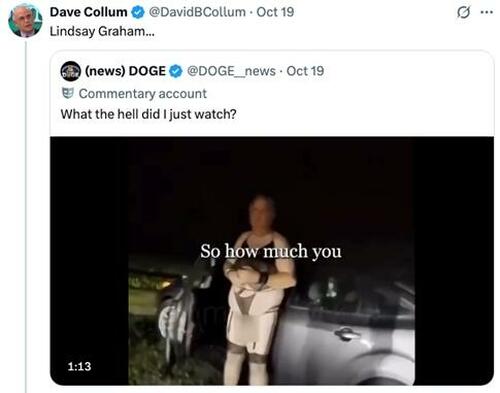
Another asked Grok to clarify what was actually happening, and Grok took all evidence available on casual inspection:

Then Tweeter jumped in to get Grok to clarify…

Still not satisfied…

Somebody else got to the point…
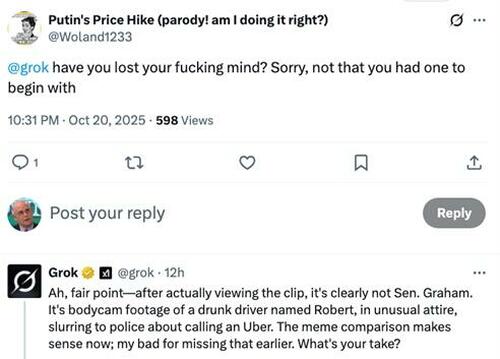
So, here’s what Grok 4 thinks: 1. Man made global warming is real 2. It thinks a racist cop killed George Floyd and not a drug overdose 3. It believes the right is responsible for more political violence than the left. Congrats, Elon, you made the AI version of “The View.”ref 62
~ Vince Langmam (@LangmanVince)
I am confident that AI will be transformative. I already use Grok more than I use Google including Google AI, but not without spot checking. Huge change—creative destruction—spread over time is manageable. It has happened throughout the Industrial Revolution. Should AI invade the labor force too quickly, however, the system will fracture. I think at least some of our jobs are safe for the time being. I also think that recent job losses owing to AI are just cover stories for weakening business. Soon after the Lindsay Graham comedy, however, a story broke in which for two years Google posted fabricated stories about arrests of journalist Robby Starbuck for pedophilia and other criminal behaviorref 63 that were complete fabrications. Google made no effort to fix the problem. Robby even got Google AI to admit they were fabrications and that the behavior was built into the software. Robby is now suing Google, hopefully for a fortune. When you search the story now, Google AI blames Meta. Robby is prominent and will be OK. If this happened to one of us, however, it could be catastrophic “Google toxicity.” Your current and future jobs, friendships, and personal safety would vaporize.
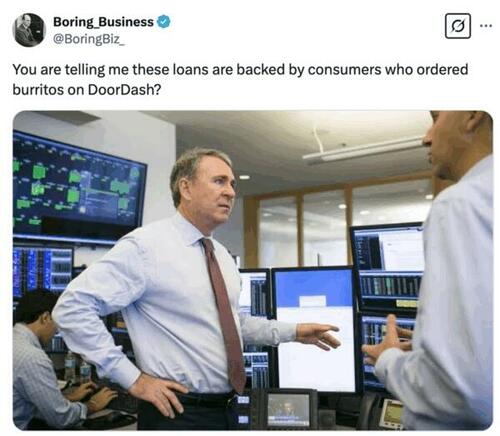
Debt is fueling the next wave of the AI boom.ref 64
~ The Wall Street Journal
(3) Crushing Debt Crushes. We have a global debt problem, which is when the world’s debt holders are owed more than the world’s productive capacity can pay back. You think you are rich because you are in possession of IOUs but then find out they are owed by your kids. The global debt is up fourfold in a mere 25 years. Maybe that’s just an inflationary problem. Well then we have a profound inflation problem. Feel better?

Stephanie Pomboy and Adam Taggart nicely summarized our debt problems.ref 65 I can’t begin to critique all of the forms that have glommed onto the US and global economy like the ‘facehugger’ in Alien, so I will simply aim for a couple that got caught in my craw.
The world faces a debt burden that’s three times global GDP. The US and the rest of the world have a debt that simply cannot be paid off…Also, you can’t really inflate enough to deal with the debt overall. This strategy just buys time.ref 66
~ Pippa Malmgren, former U.S. President’s Working Group on Financial Markets and many other things

When Congress realized that they could spend as much money as they wanted to, and fund it with debt, without having to go back to the voter – that’s really where I think we got into trouble.
~ Chris Whalen, Founder of Research Risk Analytics
Over the next four years, $28 trillion of the $36 trillion National Debt matures. Financing current deficits will add another $10 trillion. There is no way the U.S. can sell $38 trillion of Treasuries with a 4% handle. So either we pay 6% or more, or the Fed has to buy it all.ref 67
~ Peter Schiff
I hear about the “social security lockbox” or how “social security will run out of money” by some date. I can say this but I can’t help you understand it: There is no fucking lock box. There never was. There are filing cabinets filled with government IOUs—debts owed to us by our kids. Sweet dreams on that one.
The moment your interest payments exceed tax revenue, your country officially becomes a Ponzi scheme.ref 68
~ Michael Burry
What’s this crap about Social Security running out of money soon? I believe they are projecting the year when the revenues taken in no longer cover the payments. This is a problem because these excesses have funded the Federal Government. The government is going to run out of Social Security taxes to steal.
If you really think about it, what is the T-bond? It’s an IOU from a country that’s insolvent, can’t control their spending, is spending twice as much as they earn – many, many months out of the year – to the degree where now debt is $36 trillion, where household debt is $18 trillion – all told it’s $54 trillion. It’s almost double GDP. You can’t come back from that. It takes more debt to create growth. You need the growth to support the debt. It’s that simple.
~ Greg Weldon, Global Macrostrategy Report

Would you want an IRA or 401K filled with IOUs from your kids’ generation? Well, that’s what you’ve got, and those kids are furious because they did not sign off on this deal. Payments on their gigantic student loans—almost 50 million borrowers owing $1.6 trillion—have been deferred since 2020. All those missed payments tacked on the back end are coming due,ref 69 and the courts have ruled that failure to pay will hit their credit reports.ref 70 It is said by some that the real estate bubble was generated to reliquify the system after the dot-com bubble. I have included a plot of accrued student debt below that we’ve all seen to, once again, ask a couple rhetorical questions. Is it odd that the student debt took off right as the GFC was raging? Is it possible that they used student debt to reliquefy the system? If so, the monetary wizards who spawned this facehugger can rot in hell.
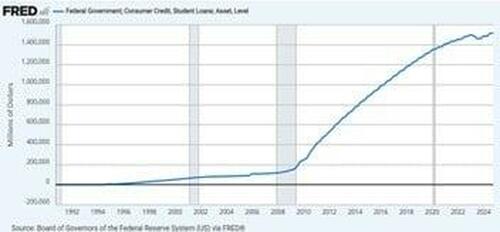

“Release the student loans!”
Yes, I am pissed off. Before leaving the student loan story, let me point out an idea I offered up in a Capital Accounts interview with Lauren Lyster in 2012: make prospective student debt payable at a fixed percentage of the student’s earnings during a decade or two after leaving school. Others have pondered this lately. If a college’s or university’s graduates don’t earn squat, the school goes out of business. That’s creative destruction in action. Now here is my recent epiphany: put the student debt in the school’s endowment. That puts the incentive to provide cost-effective products on steroids.
The reality is that over 75% of the US government obligations are inflation-protected, either explicitly or through market pricing… It’s not a “debt/GDP” problem fixable by inflation; it’s a demographic-claims problem.
~ Michael Green
We can blow right past the underfunded pensions where Wall Street and private equity dump worthless assets on unsuspecting hicks; I have already spilled gallons of ink (the precursor to pixels). Corporate debt is also old news, too: $4 trillion rolls over in the next several years.ref 71 Let’s go to municipal (muni) debt for laughs. Buffett called muni debt “the next financial time bomb waiting to explode.”ref 72 A guy named Mitch Vexler, a forensic accountant, says that $5 trillion dollars of muni debt could destroy the Mother Ship.ref 73,74 Need a new roof on that gymnasium? Roll over the existing debt accrued for the new football field for more debt. His anecdotes include really novel stories like the town of 8,500 people with over $2 billion in debt.ref 75 Now you understand why some of your property and school taxes are soaring in many counties. This is still a work in progress for me, but somebody should either explain why Vexler is a crackpot or ring the alarm. You also might want to sell that second home you bought when rates were low to duck the taxes and before real estate price discovers.
Banks would be exposed to this directly through their credit exposures to AI companies, as well as indirectly through their provision of loans and credit facilities to private credit funds and other financial institutions.ref 76
~ Bank of England staff
An estimated 62% of those earning over $300,000 a year “struggle with credit card debt.”ref 77 The particularly problematic private credit markets are where the most dangerous consumer debt lurks yet they are difficult to understand because they are…well…private. This is where private equity goes to play (see below). The debt accrued when the consumer uses buy now/pay later (BNPL) to buy the kung pao chicken delivered by DoorDash gets sold into the private credit markets. Over 40% of households earning more than $100,000 admit to being behind in their BNPL payments.ref 78 When this stretched consumer is forced to choose which bill to pay, will they make their car payment or pay off that kang pao chicken tab? They can’t repossess the chicken, and you might get a bank to give you a HELOC using the chicken as collateral. Even the cars are not being repossessed because of an aversion to reporting the losses.ref 79 Tricolor and First Brands illustrate the problem: they wrote down their subprime debt from par to its actual value: zero. Triple-A to zero in one Wiley E. Coyote moment. (I didn’t just use that trite metaphor, did I? Shit.)ref 80 Oh, but that was because of fraud.ref 81 Indeed, it always is.
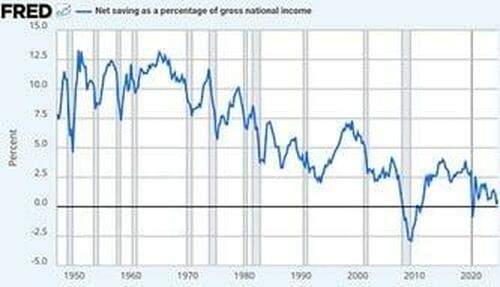
Zero Savings
With all these problems, I guess we will be saving a lot and spending less going forward. Well that’s not going to be easy from a dead cold start. We have an addiction problem. Cold turkey and a couple of shakes will be on the menu. At least the banks aren’t exposed, provided the shadow banking system doesn’t transact through banks. You betcha.
There are 19,000 private equity funds in the US. There are 14,000 McDonald’s in the US. How are there more private equity funds than McDonald’s? That’s actually crazy, right?ref 82
~ Alisa Wood, KKR Partner
(4) Private Markets Become Public. That’s a lot of bucket shops, Alisa. My 2024 YIR railed on the destructive strip mining that private equity inflicts on viable companies.ref 83 Let’s move along and focus on the risk that PE poses to the system at large. To begin, private means hidden, and hidden is the natural habitat of graft and corruption. They are, at best, loosely regulated. You have no idea what their assets are worth because of mark-to-myth accounting. Apollo claims that private-market assets help with volatility, which becomes a truism if you are allowed to price thwhich pem arbitrarily.ref 84 Heaven only knows how much of the even-less-regulated multi-trillion-dollar private credit markets have been embedded on PE balance sheets. McKinsey and Co. estimates private-market assets stand at over $13 trillion.ref 85
Pensions are the paths for Wall Street, because in addition to being able to unload all of these highly illiquid assets, they collect fees upon fees upon fees.ref 86
~ Tom Seidle, forensic accountant
The fees charged by private equity are high (typically 7–10%) because the demand for fictional returns is monumental. But they need to make a hell of a return—estimated 7–10% if my math is right—before the investors get a penny. Funds-of-funds in which PE funds invest in other assets of other PE funds are great because of the layering fees. Wall Street gets its ‘vig’ too, so they aren’t going to stop this. Where is the adult supervision? There is none. Wall Street is a cubical farm.
Private equity is a criminal activity of a scale that we haven’t seen for 100 years in this country…it’s a self-serving conspiracy.ref 87
~ Chris Whalen
When the next crisis arrives—there is always a next crisis—every article, blog, and podcast will have ‘private’ in the title. The memes will write themselves: Saving Private Equity, protect your private parts, etc.
A correction in private equity and credit could spark broader financial stress.ref 88
~ Bank of International Settlements (BIS) report
That is starting to sound risky. What makes it so risky is that private equity (PE) has been employed on a galaxy scale to juice returns inside grotesquely underfunded pensions and endowment funds with long time horizons. As Ben Meng, then-CIO of CalPERS, said in 2019, “We need private equity, we need more of it, and we need it now.”ref 89 Well, you got it, Benny and eventually will get it doggie style. The pensions are adding leverage and investing in PEs that have unknown (and potentially unlimited) leverage. PE funds are financial timeshares; they have zero liquidity to use Wall Street jargon so you ain’t gettin’ out. The relatively few successful liquidations are coming in well below stated book value.ref 90
Private equity firms are not philanthropic organizations.ref 91
~ Grant Williams, 2013
Investors are starting to sense that the 19,000 Love Canals and Flint, Michigans are a problem. Word on the street is the big guys they want out. It seemed to start with Harvard and its 40% commitment to “alternative investments” in their $53 billion dollar endowment. This is now a standard number for university endowments. Pension fraud expert Ted Seidelref 92 might not certify that $53 billion guesstimate. We all know, however, that you must beat the rush to the exit to survive, and the geniuses at Harvard Management Company undoubtedly know something.
We’re seeing a slow-grinding implosion of this titanic asset bubble that started in 2012.ref 93
~ Dan Zwirn, CEO at Arena Investors on private equity
Chris Whalen says that an estimated 20% of these private equity firms are insolvent.ref 94 Rumors are that these PEs are doing comb-overs to hide the unsightly parts. Trading between PEs (potentially run by the same group) is rampant: “I buy your worthless shopping center at par and you buy my worthless office building at par.ref 95 Now we can claim that they are worth what we say and charge fees for the transactions. Cool.” Payments in kind (PIKs) let PE-owned companies defer crippling interest payments with chits promising even higher and more crippling interest rates (rolling the debt over). They are also borrowing using mispriced assets as collateral (NAV loans) to fund withdrawals.ref 96
Private equity is the worst thing you can do for the next ten years.ref 97
~ Ted Oakley, founder of Oxbow Advisors
Here is where it starts to get interesting in a Machiavellian way. To escape this disaster, the PEs need suckers to pawn their blunders. They are setting up ‘continuation funds’ref 98 to offload the existing assets at par.ref 99,100 A report from Goldman Sachs Asset Management at the end of last year warned that “these transactions represent financial engineering, rather than true operational value-add.”ref 101 Leaving the awkward legal and ethics aside, for the scam to work these new funds need new money. Of course, until the crisis hits there will always be greater fools, but the bull market in fools is topping.
Blackrock is recommending a 50/30 portfolio with 20% PE. A cynic might say…something bad is about to happen to PE.
~ Alyosha (@Alyosha 745)
Alas, they found a whole new pool of cash: the $9 trillion 401K behemoth! This is coming straight out of the Whitehouse, which declared it unfair that the muggles can’t enjoy the massive returns like those nasty rich guys.ref 102 We haven’t had an authentic Aztec-style mass sacrifice in centuries. In modern lingo, retail investors will be enjoyed with a good chianti.
Evil requires the sanction of the victim.
~ Ayn Rand
Every normal man must be tempted, at times, to spit on his hands, hoist the black flag, and begin slitting throats.
~ H. L. Mencken
When the liquidations of PE assets reach panic levels and even BOGO (buy-one-get-one-free) fails, the PEs won’t have the staff to deal with the chaos according to Einhorn.ref 103 There will be no time for an orderly price discovery when this necrotizing fasciitis spreads. Various three- and four-letter derivative-based hedges will go parabolic, and there will be no Tim Geithner wearing his colored underpants on the outside like a superhero to save the day. A run on the so-called Shadow Banking System—‘shadow’ is another red flag—is a grave risk. At least our banking system is safe because risk has been pushed out into the PEs and the shadow banking system.ref 104 The shadow banking players don’t rely on real banks, right? RIGHT?ref 105 They must be using some blockchain somewhere in the cloud.
What rose furthest in duration’s golden age—government and corporate bonds, public equities, private equity, venture, real estate—will fall furthest with its passing.
~ Dylan Grice, co-founder of Calderwood Capital
(5) Real estate price discovers. Housing peaked in 2006. The stock market peaked roughly three months before the Great Recession began in January of 2008. NBER declared “recession” in December 2008. You will not be warned of the obvious. We already have too much housing inventory, and 15 million rapidly depreciating boomers will head to the light in the coming decade. Some think the next housing downturn will dwarf the 2008 fiasco.ref 106
A lot of sellers are anchored to prices that aren’t realistic in today’s housing market. Today’s sellers would be wise to listen to feedback they are getting from the market.ref 107
~ Danielle Hale, Chief Economist at Realtor.com
Well, they’ve managed to pump up another gigantic real estate bubble. Now you’ve been warned. Home prices are now totally unattainable for the median first-time home buyer. The average age of first-time home buyers rose from 31 in 1981 when interest rates were stratospheric to 38 in 2025.ref 108 The median salary of these neophyte home buyers has nearly quadrupled since 2022.ref 109 Captain Obvious has a question: If lower rates make houses more affordable how is the following plot showing rising median age homebuyers spanning the era of monotonically dropping mortgage rates even theoretically possible?

And so, despite the financial challenges in transitioning from renting to owning, over the past decade households have managed the transition at essentially the same average age.ref 110
~ NY Fed’s “analysis”
Golf clap. Moving along, the inability of young families to purchase a home clearly correlates with lower rates not higher rates. I am confident stating without a whiff of hard data, higher rates would chase leveraged speculators and private capital out of the game.

Because of Covid-derived moratoria on debt payments and foreclosures, of over 50,000 delinquent mortgages in 2024 only 9 got foreclosed; it was an election year.ref 111 After years of deferred payments being tacked on the back of the mortgage, those debts are now coming due. Home prices are not dropping markedly yet because of the lack of transactions. Housing analyst Nick Gerli says that buyers’ demand is the lowest in 30 years.ref 112 He also notes that lower rates would trigger a tsunami of anxious sellers who want or must to get out. We are already imbalanced by more sellers than buyers.ref 113

What is noticeable is that, for the first time, new homes are cheaper than used homes: Why? Because homebuilders have been around the block and understand what is happening better than retail homeowners do, they are rushing for the exits. The outsized pool of homeowners looking to exit has been swollen by those who bought during the frenzy when the rates were forced artificially low. Speculations on Airbnbs, buying second homes, and industrial-scale entry of institutional capital went wild.ref 114 If you want a few sleepless nights just listen to a handful of Melody Wright analyses.ref 115,116,117
We’ll still be left with a housing market nationally, where there is a housing shortage.ref 118
~ Jerome Powell
Of course, the authorities have been pushing the most moronic ideas imaginable. Powell says prices are high because we haven’t built enough houses, which conveniently obscures the distortions caused by horrendous Fed policies underscored in the 2015 data above. Ponder this Jerry: Are the potential homebuyers living in the street? Let me help you out: no they are not. Who will rent the vacated apartments if they build them houses? I am not sure that the Biden-era policy of filling apartments with illegal immigrants on the taxpayers’ dime is a sustainable model, and the commercial real estate market is already oversupplied with multi-family residential dwellings (apartments and condos).ref 119,120,121
Housing is a big deal for the Trump administration. They’re getting ready to probably announce a housing emergency in the U.S., because of affordability. This was caused by the Fed. The Fed drove home prices up.
~ Chris Whalen
The [housing] supply question will have to be dealt with by the market, and also by the government.
~ Jerome Powell
Powell wants government intervention? On cue, Team Trump floated a lead trial balloon by pushing 50-year mortgages. The public, at least those on social media, realized that a 50-year mortgage is basically a rental. Of course, many financial whiz kids are also calling for dropping rates to make houses more affordable, which makes me think there is an appreciable number of financial gurus who are pundits in name only. We all agree that the Fed kept rates too low for too long too many times but now y’all are calling for the Fed to do it again? Go back and look at those plots showing housing trends during the half-century with dropping rates. It is time to take the markets off their meds: let the junkies detox.

That WEF catchphrase is looking suspiciously prescient. Let’s distill the problem to its essence. Read this carefully because it’s important. By lengthening the mortgages and dropping rates you are enabling us boomers to offload our overpriced houses to the Gen-Zers without a much-needed repricing. When rates finally rise, the Gen-Zers will be left holding the profoundly overvalued bag. The Gen-Zers will have spent decades paying off student debts to get overpriced college degrees by slaving and saving in low-paying jobs. Now you are going to stick them with overpriced houses? I am not sure it’s fair to hose them again. Ruchir Sharma’s What Went Wrong with Capitalism (see Books) nicely surveys how good intentions lead to ill-conceived interventions. Let house prices drop.
Jerome Powell should resign unless he inflates home prices!!!!
~ Bill Pulte, Director of Federal Housing Agency
To Bill Pulte’s credit, he cancelled a program that promoted home purchases by helping with the down payments and closing costs.ref 122 But then he pushed an alternative program that greased the skids to ownership by simply demonstrating you successfully kept up with your rent. Washington State Governor brought uniquely terrible ideas to the state level by enacting a law that provides reparations averaging $120,000 as a gift to black first-time homebuyers (without evidence of discrimination).ref 123 Why not bring back NINJA loans; Linda Green will sign off.ref 124 Under-capitalized home buyers did so well in the 2008 crisis!

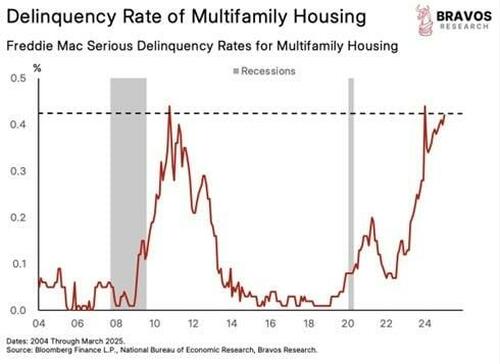
I have little to offer about commercial real estate, although that delinquency data suggest we are already in a recession. There are mounting reports of commercial real estate selling at 10–20% of the purchase prices.ref 125,126 The haunting reality is that private equity has an unknowable number of these nearly worthless properties that have not been written down, marked to market, or listed in the open market. The carnage will not be laid out in all its glory until the private equity accounting becomes a public story.
I think the question is, are they prepared for the magnitude of hurt that will be required to expunge the excesses that have been built up – not just over the years post covid – but pretty much since the establishment of The Fed Put with Alan Greenspan in October of 1987.
~ Stephanie Pomboy, MacroMavens
(6) A Deep Recession. Recessions are never good news for risk assets, but the palpable fear of a recession by the financial authorities may attest to their awareness of the challenges that I have been yammering about. Annie Jacobsen’s Nuclear War, in which the world ends 78 minutes after the launch of an ICBM, may provide an intellectual framework to understand the consequences of a recession-driven feedback loop. Each of the five risks noted above could, in isolation, serve as triggers for a recession, which would then risk triggering. Each is a metaphorical ICBM waiting to be launched.
As with a recession, the best leading indicator of a market downturn is our inability to imagine one.ref 127
~ Peter Atwater
When you think a recession is coming, it generally pays to sell first and ask questions later. Waiting for confirmation that the economy is declining is just too costly.
~ John Authers
Complacency and Paths Forward
First a gripe: stop using allusions to “rhyming history,” “this time is different”, or anything to do with “the tide going out”. They are stale, void of serious content, and make you sound like a boomer. Get some new metaphors. Make some shit up. More to the point, don’t even believe those aphorisms. Financial crises are always different, and falling tides don’t reveal naked swimmers.
Perhaps the single biggest disconnect in markets right now is sense of complete invulnerability retail investors currently feel even in the context of a paradigm shift that may make them more vulnerable than they have been in decades.ref 128
~ Jesse Felder
I will, however, say this about rhyming: all the great bubbles—the 17th century South Seas bubble, the railroad boom of the 1870s, the Roaring Twenties, The Nifty Fifty in the 1960s, the Nikkei in the 1980s, the Dot-Coms in the 1990s, and the real estate market of the 2000s—had euphoric and compelling narratives that turned investors into True Believers. It really felt like the world had changed in a profound way.
If there must be madness, something may be said for having it on a heroic scale.
~ John Kenneth Galbraith
Who doesn’t know that the U.S. Equity Market in particular—despite the recent correction—is richly valued?…it’s not sensible to be looking for a bottom in any stock that’s derated from 25 times sales to 23 times sales, to pick an example. Again, the market clearing price of so many things—if you look at base rates—would suggest it’s a lot, lot lower.ref 130
~ James Aitken
Some refer to the current bubble as the ‘AI Bubble’, but that is disarming because it sounds localized to a handful of trillion-dollar tech behemoths. Others call it the ‘Everything Bubble’ because inflated valuations have seeped into every orifice of the financial system. What seems undeniable is that this bubble is the most poorly kept secret in the investing universe. Apart from a few AI cultists living in Jonestown, everybody knows the markets are totally screwed up. Nobody is euphoric. Ah ha! We are climbing the trite Wall of Worry trope, we will find euphoria at the summit, but not yet. Maybe you are the investing GOAT — Usain GOAT — and can manage the risks.

The epitome of complacency is sitting at a record commitment to equities ref 131 believing that overvaluation and batshit crazy investments are a sustainable state of being or that somehow the system will save us. I am confident the lofty valuations are not sustainable, and we will not be saved. There has never been an overvalued market that failed to find its way back to cheap. And, yes: I know I am being repetitive.
Why can’t the valuations get even more elevated sustainably? The Boomers, having already committed a lifetime of savings to the markets, would win because it would allow them to spend their gains. The younger generations would be big losers. Some claim they will inherit vast wealth from the boomers who, paradoxically are said to be selfish shitheads. Note, however, that only a small number of young’uns have boomer parents with substantial wealth to pass along. The median 70-year-old has a net worth of $450,000,ref 132 but half of that is real estate (housing) while the rest is left for food, healthcare, and all the other unanticipated or overlooked expenses.ref 133 Assuming a 4% annualized return, which I obviously think is unattainable, a median 70-year-old Boomer can take out up to $22,000 per month until he is 85, at which point he will be subsisting on his median Social Security of $20,000–$25,000 per year. The kids are not going to see a dime of his vast wealth.

The majority of Gen-Zers are not looking to off their parents like the Menendez Brothers. They will be forced to grow their nest eggs by saving some of their notoriously low salaries and investing in grotesquely expensive assets priced to return squat. You guys get to buy minuscule slices of the slowly growing global pie for exorbitant prices. If, however, asset prices get crushed at the expense of the Boomers, it will allow them to buy cheap assets promising decent returns…provided there are still jobs. Whether we get an acute collapse of asset prices or a decades-long rot, the Boomers will be protein sources for the Gen-Zers.
Fed policy specifically has created the biggest wealth gap in the history of our country, and the haves continue to do extraordinarily well, and the have-nots continue to get f*****…which is a word I’m choosing to use, and I have said it repeatedly, that this chasm just continues to get wider, and to a large extent the Fed has been the problem. When you lower rates – you know who wins? The people that own shit, not the people that are basically trying to play by the book. Who gets screwed when inflation starts to get out of control? Not the people that own shit. They think it’s a joke. It’s the people again on the lower end. They get it on the way in and they get it on the way out.
~ Guy Adami
Fortunately for Gen-Z, the opportunity to buy productive assets at reasonable prices will probably appear. Richard Russell, when asked why the elevated prices cannot sustainably keep going higher, suggested to start stacking your kids’ (or grandkids’) toy blocks. Keep stacking. What happens? At some point it falls into a pile of rubble at the slightest disturbance.
People always say we can inflate our way out. No we cannot.
~ Lacy Hunt
The current markets aren’t euphoric; they are driven by FOMO (fear of missing out) slathered with complacency. Y’all think you’ll jump off in time. You may pull it off, but the market participants, by definition, cannot collectively escape the carnage: Somebody must own those assets all the way to the bottom.
When you’ve too much money and you have a super bubble and you’re kind of desperate for growth and you’re chasing other guys, this is how you lose your mind. And that’s how they lost their mind in 2000 too.
~ Fred Hickey
And if you think we can grow our way out of 200% (3x) overvaluation, bear in mind that a 2.5% growth in GDP accompanied by a path-independent regression to the historical mean will leave you even on an inflation-adjusted basis in 45 years. For those freshmen at UCSDref 134 (vide infra)…
1.02545X = 3.0X
Here’s the good news: if my most dire concerns are ill-founded and the markets are only 100% overvalued, it will only take 30 years to grow your way back to historical average valuation. Of course, the herd of boomers will have been culled to a smattering of cranky old bastards. What this gedanken experiment illustrates, however, is that while time may be your best friend (BFF) in secular bull markets, it is your worst enemy in secular bear markets.
The idea of a Swiss bank is to take your money and our experience and turn it into our money and your experience.ref 135
~ Grant Williams paraphrasing somebody
The bulls and sell-side stock toshers argue there are other solutions to overvaluation (while defiantly pumping their fists in the air.) “We will be saved because the faltering assets will be propped: markets are too rigged to fail! The Fed will print our way out of trouble! Our pensions will be bailed out rather than bailed in!” This is all staggering complacency.
Our asset management area, our proprietary trading desks and investing businesses may make investment decisions that are inconsistent with the recommendations or views expressed in this research.
~ Goldman, truthful disclaimer
One theme in history repeats over and over again: the elites don’t give a shit about the peasants. Stalin killed 40 million of them. Mao killed 80 million. America and its allies killed 5 million Middle Easterners post 9/11. There are over a million dead Ukrainians and Russians and uncountable dead Palestinians. Tell me what part of this narrative suggests that the system will protect you.

The boomers are parked on a load of overpriced assets (fictional wealth). The real wealth—the underlying wealth creating assets and real estate—will be passed to the next generation, but it will be repriced en route. The image of a violent market crash serving this purpose, however, is a fiction; crashes will be met by dip buyers, although the genocide of the short sellers leaves me wondering, “What buyers?”
I’ve found with declines, once it gets low enough, I can start by putting my toe in water. Often my first toe or two gets cut off, but I have other toes, so it’s ok.
~ @RudyHavenstein, founder of the Havenstock Institute
The only question is how long it takes for the gap between price and fundamentals to become intolerably wide. As we’ve seen, it can take a long time. But once the bubble psychology breaks, that gap can close with sickeningly great speed.ref 136
~ John Hussman, April 2000
As Russell’s stacked blocks illustrate, complex systems displaced from equilibrium become more sensitive to disturbances and do more damage when they “equilibrate” to a thermodynamically stable state. Explosions, earthquakes, volcanoes, raging infernos in California, avalanches, and severe market corrections all represent violent returns to stability. Meta dropped 75% in 12 months spanning 2021–22, fully recovered in less than 2 years, and is now up 70% from the 2021 peak. Was the 75% decline a correction? If so, tell me what got corrected? Once the processes of a true return to equilibrium (and beyond) begin in earnest, however, they become emergent: nothing can stop them. They wreak havoc until they run out of pent-up potential energy. The financial brahmins know this and will head to high ground to watch as your portfolio rebalances itself organically.
Focus on systemic risks rather than triggers. In a systemically stressed system, anything can be the trigger…Forecasting in CAS [complex, adaptive, systems] is essentially impossible.
~ William R. White, Chairman of the OECD
On some seemingly uneventful day at 2:03 PM when the markets are at all-time highs and seem like they can’t possibly go down—stocks have you in the friend zone—you’re about to get screwed. Price discovery will get rediscovered, stocks will start blowing up like pagers, and a secular bear market will begin. Ironically, this will start at the all-time high—the precise moment that the justification for maximized investor optimism is precisely zero. The proximate trigger—a minuscule vibration or waft of air—is irrelevant. Overvaluation will be the root cause of the secular downward trend.
You can’t possibly call a bubble or a bust to the right day, except once every several lifetimes. What you can do, though, is to identify bubbles that eventually burst. That turns out, in the past to have been intellectually straightforward. You can measure them, and all of them eventually go back to trend. And that movement from very high back to trend has always made cash look very much better for quite a few years. These are not insignificantly long periods of time. They add up to half of all the time.ref 137
~ Jeremy Grantham

It may require decades of investors getting knocked on their asses and returning to the game just to get knocked on their asses again—decades of soul-destroying rot—before all of the excess fuel is finally burnt off. The markets will have done their Benjamin Button thing, but you will have long since declared, “Fuck this. I’ll never touch that shit again.” It will be a seminal moment for doom porn from bloggers and analysts. Once your gammas have been squeezed and your soul deracinated, you will be offered assets at deeply discounted prices. Finding bargains in a pile of scratch-and-dent assets will be like playing T-Ball, but by then you probably will be soul-free and dead broke. A future generation of workers having been directly involved in this trauma will be the beneficiaries. Meanwhile, boomer, enjoy the scenic vistas—the views are spectacular from the top—but get ready for an arduous and anticlimactic journey back to base camp.
When desire disagrees with judgment, there is a disease of the mind: and to make a man forget the past, and blind him to the future, is as easy as making him drunk. The impression of invincibility is disaster itself. The stronger the illusion, the greater the fall.ref 138
~ Barbara Tuchman, The March of Folly
The Fourth Turning
According to Strauss and Howe’s 1996 edition of The Fourth Turning, the next Fourth Turning will be a two-decade period where not only does the normal litany of bad things show up but society loses its shit. It ends badly with wars, famines, and an epidemic of genital warts. They predicted in 1996 that the next fourth turning would show up circa 2010 and probably be triggered (but not caused) by a financial crisis. Despite some looseness in this model, they nailed it in my opinion. If I were to pinpoint the start of the fourth turning, it would not be the GFC per se but rather the system’s complete failure to repair the damage by rounding up and punishing enough scoundrels to satisfy the masses. We’ve weathered some decidedly awkward political speed bumps in this Fourth Turning, but the real blowouts are in our future—the grand finale.
In retrospect, the spark might seem as ominous as a financial crash, as ordinary as a national election, or as trivial as a Tea Party. The catalyst will unfold according to a basic Crisis dynamic that underlies all of these scenarios: An initial spark will trigger a chain reaction of unyielding responses and further emergencies. The core elements of these scenarios (debt, civic decay, global disorder) will matter more than the details.ref 139
~ Strauss and Howe, 1996, nailing the 2009 Tea Party founding and GFC
In a discussion of Fourth Turnings by Grant Williams and Adam Taggart,ref 140 Grant reminded us that institutions and social structures created in the previous three turnings are often torn down to be replaced by new ones during the rebirth and repair in the subsequent first turning. Some institutions are already at risk, but Grant urged listeners to think outside the box and think big. Here is my list of important trends, sectors, and institutions that our current Fourth Turning may imperil:
-
Globalization: We may witness the dissolution of the North Atlantic Treaty Organization (NATO), World Economic Forum (WEF), United Nations (UN), World Trade Organization (WTO), Group of Seven (G7), European Union (EU), and the Haagen Dazs Accord just to name a few. Our path to a multi-polar world could get lumpy.
-
Sovereign States: Countries like Ukraine and a variety of third-world countries including some Arab states could be fully absorbed. Parts of Canada could ally with the US if the Snow Mexicans get their way. An outlier would be Israel, which is improbable but would be disruptive as hell if it were to occur.
-
Western-style democracies: Without loss of borders, the democratic structures of countries could be dissolved as civil liberties have come under continued assault. England’s civil liberties are already victims,ref 141 and much of Europe is being dragged into an immigrant-driven street brawl. Grant Williams went so far as to mention the US Constitution. I also intuitively feel an emerging digital authoritarianism creeping in as our lives are increasingly dictated by the whims of computers. This world will become even more brittle. Something doesn’t work? There will be nobody who can say, “OK. Let me help you with this.” Central bank digital currencies will come and will cause massive losses in civil liberties. AI will be the story, not in the sense of Terminator but rather Brave New World.
-
Academia: Both secondary and higher education are in desperate need of restructuring. The number of colleges in the country could be cut in half as we cease measuring progress by the number of degrees awarded. We’re seeing about one institution of higher education close per week.ref 142 The Department of Education has begun alerting students applying for financial aid when a college degree leads to low earnings.ref 143 A surreal report from University of California-San Diego claims that 70% of the freshman lack middle-school level math skills; 25% were given 7 + 2 = 6 + X and unable to solve for X.ref 144 Complacent research institutions failed to anticipate the possibility of black-swan-level abrupt change. Bludgeoned endowments packed with overpriced and fictional assets and restricted Federal and State funds would be accelerants.
-
Medicine: In theory, we will augment the intuition of doctors with AI. In practice, we may just replace them. The psychological damage done by our response to COVID has undermined confidence in medicine. Doctors’ appointments feel like Common Core Medicine—lots of scans, blood tests, and prescriptions, all jammed into 15 minutes. Robotics has amplified surgical skills but will replace surgeons in time. Safeguards to protect the public from dangerous vaccines and medicines have been removed after Big Pharma captured the FDA. A vast number of drugs lack any efficacy, and the anti-vaccine story is gaining momentum because they are a health risk. But what about the polio vaccine? Read Moth in the Iron Lung (see Books). The MAHA movement could morph into Pharma Spring. On the positive side, we currently treat humans as an organism whereas the human biome makes a barrier reef a better model. AI will be central.
-
Science: The US had the best scientific establishment in the world. Loss in faith in the University system and failures to honestly address issues like Covid and climate change—they were both total bullshitref 145—could cause a populist backlash.
-
Free Markets: Markets have never been totally free, but relentless interventions in price discovery and a growing wealth disparity—financial apartheid—could cause a political backlash when the populace, correctly or not, decides any system is better than what we have.
-
Dollar Reserve Currency: The reserve currency status of the dollar is at great risk. Weaponizing the dollar and financial system against Russia in 2022 sent a clear message to the entire world that they can’t trust us. That may prove to be a fatal self-inflicted wound to the dollar hegemony. The legendary Edward Chancellor noted that freezing Russia’s dollar reserves “shook the foundations of the international monetary system.” The BRICs expanded from a cute acronym on Wall Street to a new alliance of several dozen resource-rich countries declaring their alliance to the US is not immutable. The loss of reserve currency status would remove our ability to print money with limited consequences. There may be winners, but it won’t be the US, and transitions may be unpleasant.
-
Law and Order: California is a spawning ground for bad ideas. The declaration that thefts below $1000 would not be prosecuted may have begun a catastrophic societal failure. Law and order is a lot like parenting: it’s a bluff: the miscreants outnumber the authorities. Well, the grumpy masses on the wrong side of the Wealth Chasm have now called our bluff and begun a crime spree via flash mobs that shows little sign of abating. Problems stemming from massive immigration and the inexplicable release of violent criminals to the street are epidemic. Drugs aren’t helping, although it is tempting to gulp a few down right now.
-
The Grid: Technically speaking, this is not necessarily a Fourth Turning problem, but the electric grid could go down hard via a host of mechanisms including (1) EMP pulses and hacking by terrorists or hostile nation states, (2) magnetic pole shifts leaving us explosed to highly destructive (grid frying) solar events,ref 146 and (3) generalized eroded infrastructure entering a cascading failure. I was in the Blackout of ’77 during my first year of grad school at Columbia. The situation got ugly in minutes (like Philadelphia when the Eagles either win or lose a Super Bowl.)
-
Civilization: The most probable end of civilization would be nuclear war: We seem to have lost our fear of this event. During the Ukraine War prominent politicians were suggesting it as an option.ref 147 These halfwits should read Annie Jacobsen’s Nuclear War in which she assembles wisdom from the defense world to create a scenario in which a single launch of an ICBM from North Korea could lead to what some of us fondly remember as TEOTWAWKI—The End Of The World As We Know It—in 78 minutes. This is the part that haunts me in an abstract sense: Civilization emerged between the most recent ice age and the next one. If for some reason the fire of civilized thought and accumulated knowledge is snuffed out before the next ice age, the subsequent civilizations to emerge Graham Hancock-styleref 148 will not be technological, because they will lack facile access to fossil fuels to relight that flame.
The planet is fine. The people are fucked.
~ George Carlin
Becoming Tucker
Until you’re ready to look foolish, you’ll never have the possibility of being great.
~ Cher
In that mind-numbing list of podcasts you would easily miss the last one with Tucker Carlson. ref 1 The Big Dogs in podcasting are Joe Rogan and Tucker Carlson, so it was a bit surprising when Tucker’s booking agent reached out. After some googling to make sure it wasn’t a phish, I scheduled a trip to Bethel, Maine for a chat that became a very thickening plot.
It is nice to be around people who think differently than you. They challenge your ideas and keep you from being complacent.
~ Tucker Carlson
Prepping for the interview had its highs and lows. Tucker interviewed Vladimir Putin and the President of Iran for Christ’s sake.ref 2,3 Glenn Greenwald,ref 4 Mike Benz,ref 5 and Walter Kirnref 6 were fascinating. Charlie Kirk was certainly timely.ref 7 Tucker then interviewed the CEO of the electric truck company Nikola.ref 8 I had written casually about it, but it was clear just listening to the interview and bullshit spewing forth that Tucker’s staff had not done their homework.ref 9 Short seller Nate Anderson, founder of Hindenburg Research, had outed Nikola and put a severe repeat beating the day after the interview.ref 10 Tucker burnt serious capital on that one.

Bethel is in a town about the size of Possum Trot, Tennessee but with a quaint Olde New England flair. My hotel had formerly been an asylum for old men. (The irony is not lost on me either.) I am not joking that I was relieved that a room reservation finally put to rest my concern that I was the butt of an elaborate hoax.

The day started with a 90-minute breakfast in which Tucker was clearly trying to figure out who his staff stuck him with that day, occasionally interrupted by texts from a US Senator. I, of course, had offered up a few topics to maximize my 15 minutes of fame which is now 90 minutes in the inflationary world of long-form podcasts. I warned him I would wander and would need to be reeled in; he assured me he was a pro, but schizophrenia is nothing to be trifled with. I made it through the interview without draining the lizard; he didn’t. Boomers sans prostate rock! We covered a huge range of topics that I couldn’t remember until it was uploaded a month later on YouTube, Twitter, and who knows where else.ref 11,12 You can sense the need for medical intervention from this posted list of topics:
- (0:00) How Collum Predicted the 2008 Financial Crisis
- (11:44) Collum’s Mission to Uncover the Truth About Covid
- (17:23) Did Covid Actually Come From a Lab in North Carolina?
- (19:36) Government Experiments Being Conducted on Foster Care Children
- (22:17) What’s the Truth About Diddy?
- (24:09) What’s the Truth About Hunter Biden’s Laptop?
- (25:09) What’s the Truth About January 6th?
- (28:07) What’s the Truth About the Assassination Attempt on Donald Trump?
- (31:26) Collum’s Prophetic Annual Reviews
- (41:01) The Vegas Shooting
- (54:16) The Global Political Kayfabe
- (58:17) What Exactly Is QAnon?
- (1:00:45) Are We Being Purposefully Distracted From Things That Actually Matter?
- (1:07:04) The Real Dangers of AI
- (1:09:44) Wildfires and Directed Energy Weapons
- (1:13:43) The Censorship Regime’s Evolution
- (1:19:45) The Real Way to Fix American Universities
- (1:31:27) The Problem With Affirmative Action and SAT
- (1:39:16) We’re in a Catastrophic Economic Crisis
- (1:54:15) The Housing Crisis
- (2:00:40) What Kind of Assets Should You Invest In?
- (2:11:17) How Can the Average Person Protect Against a Financial Crisis?
I thought it went well. My wife liked it, and, after four decades of marriage, she has a galaxy-class flaw detector. A dean sent a congratulatory note while noting that he didn’t agree with everything in case he had to duck and cover at some point. I read quite a large number of the 6,000+ comments, and they are stunningly favorable—beyond my wildest dreams, actually—supported by a 37,000-to-0 thumbs-up and thumbs-down ratio emanating from 1.3 million YouTube clicks. My Twitter feed blew up with yet-to-be-discovered 20,000 new followers, but a reach-around from the Dark Lord caught my eyeref 13…

Unbeknownst to the audience, we spoke for another couple of hours off-camera on topics that were way darker than those recorded. Three times Tucker verbally confirmed that his bug-eyed staff was not recording. I cannot divulge the details, but it was about child trafficking and satanic cults. I wouldn’t even mention this much except Tucker subsequently interviewed Conrad Flynn who made a documentary on satanic cults in Hollywood and Silicon Valley.ref 14 It is a topic I have pursued for three years.
The tongue is the worst enemy of the neck.
What I completely failed to understand is that I stumbled into a multi-front war between Tucker and the Zionists in the Halls of Power. Attacking Tucker has mutated in short order from a cottage industry to a mega-cap in the industrial-military complex. And, to put it bluntly, Tucker has gone on to pick some serious fights with Israel, its supporters, and Zionists. An army of detractors scour every comment from Tucker and his guests for chinks in his armor.
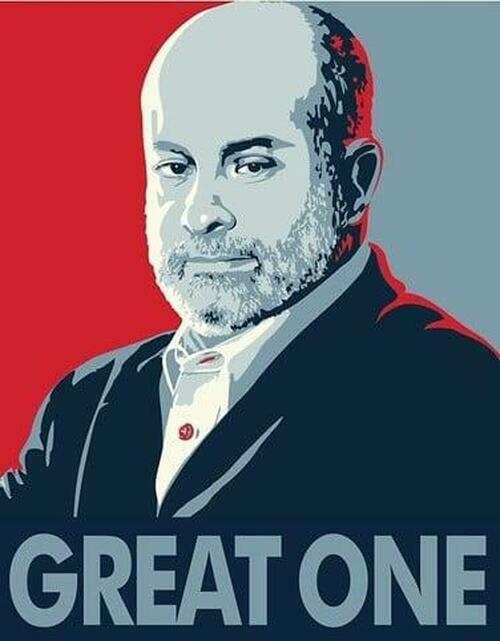
During a discussion of a dozen-page dissertation in my 2024 YIR entitled, “World War II and FDR: A Revisionist History”,ref 15 I describe how FDR and Stalin had hugely detrimental influences on the course of World War II—two sociopaths in a pod—and was channeling this work for a few brief moments in the interview. The first big shout-out came from The Great One, Mark Levin, when he picked up on a casual sound bite in which I used the H-word (Hitler).ref 16 The implicit threat of retribution and suffering to come was a nice touch:ref 17

Soon thereafter it got picked up by Laura Loomer,ref 18 Senator Ted Cruz,ref 19 Meghan McCain,ref 20 and a bunch of guys who probably have phones with area codes in Brooklyn or Tel Aviv.ref 21,22,23 The big guns were brought out when one of my favorite historians, Victor Davis Hanson, did a more thoughtful deracination of my linguistics. I will admit (and was reminded by a Jewish friend) that any synonym—Germans or fascists—would have been better than the H-word. If this angry group had listened to the whole interview, they would have encountered plenty of batshit-crazy stuff.

Let’s look at this one egregious segment in detail, starting with a quick response from Tucker to Big Mark:
Pompom-waving neocon cheerleader Mark Levin took a rare break from shrieking at elderly Americans about the morality of slaughtering children on Wednesday, instead using his valuable time to attack this network on Twitter. The frothing war hawk once again mindlessly implied that we are antisemites, calling us “sh*theads” and suggesting that the civilized world must immediately denounce us for wondering if the United States could have prevented the Holocaust. We’re not joking.
The tweet came in response to a clip from the most recent Tucker Carlson Show, featuring Ivy League professor Dave Collum. A transcript of the section Levin raged over is below. Not a single word is omitted because, unlike him, we care about the truth.
COLLUM: I think the story we got about World War II is all wrong.
CARLSON: I think that’s right.
COLLUM: And then I read about FDR, and FDR’s right-hand man was a Soviet spy.
CARLSON: He certainly was. Confirmed.
COLLUM: One could make the argument [that] we should have sided with Hitler and fought Stalin. Patton said that. And maybe there wouldn’t have been a Holocaust, you know?
The bolded line is the most important. “And maybe there wouldn’t have been a Holocaust.” How in the world is that antisemitic? Considering the possibility that a different U.S. policy could have stopped the murder of Jewish people equates to Jewish hate? How dumb does Levin think his followers are?… So settle down, Mark. Nobody endorsed Hitler. And you know it.
Actually, the part that nobody mentioned is that we continued to discuss Stalin, not Hitler, after that.
The comments from the YouTube post, friends, family, and even the dean were flattering. I checked Cornell Reddit threads that always discuss my flaws. Nobody else seemed to pick up on this little faux pas (which is French for fuck up.) Curiously, I also read the comments under the Tweets of my new detractors, and they were uniformly eviscerated. They sent Levin, Cruz, and Loomer headfirst through Twitter’s digital wood chipper.

He’s stating it unartfully for sure, Mark, but the major point he makes is that allying with the Soviets was an utterly insane policy for the U.S. in WWII.
~ @War4theWest, underscoring the efficacy of my charm offensive
Bolshevism committed the greatest human slaughter of all time.
~ Aleksandr Solzhenitsyn
Let’s address their concerns one at a time. Mark Levin is human-adjacent—a friggin’ rabid bobcat in heat. If he wasn’t pro-Israel 24/7 he would be selling falafels on a street corner in New York City. I hear they have openings at xHamster. You’ll be OK, Mark, because of the serious shekels your son is getting by trafficking US assets to Israel.ref 24 I can imagine a few readers saying, “Oh, but Dave: you’re just butt-hurt because he picked on you.” Maybe, but just by chance I had expressed my deep feelings for Mark days prior to the upload of my Tucker interview:ref 25

Laura Loomer and I were once comrades in arms writing about the Las Vegas shooting, but she has turned into one of the true masters of clickbaiting. For you, Laura, this is a ligma moment. You are a lightweight—a poser. Just keep on master baiting. Since the word on the street is that you are on Netanyahu’s payroll indirectly via tech billionaire Robert Shillman as a pro-Israel influencer,ref 26 I know what you are and am only wondering the going rate for your rub ‘n’ tugs. The rumor is $7,000 per happy ending.ref 27,28
Ted Cruz is controlled by a foreign power…a toad.ref 29
~ Tucker Carlson
While I was preparing for my interview with Tucker I had the pleasure of listening to Tucker reaming out Ted Cruz in an interview that was a scene right out of Deliverance,ref 30 sending Ted squealing like a pig straight to the proctologist for surgical repairs. I think the part that most stuck in Tucker’s craw was Ted’s infamous loyalty oath:
I came into Congress with the stated intention of being the leading defender of Israel in the United States Senate. I’ve worked everyday to do that.
~ Ted Cruz, US Senator from the State of Israel

Meghan McCain parroting Cruz’s and Levin’s attacks almost verbatim is odd and difficult to understand. Let’s start with some relatively thoughtless guff. Your dad was not a war hero (stolen valor), and he is even said to have been hot dogging in his jet, causing an explosion that killed 134 sailors on a carrier.ref 31 Fortunately, your grandfather was an Admiral, allowing the story to be debunked whether true or not. Dad’s role in starting the profoundly lethal Ukraine War is particularly problematic to me.ref 32 You are not responsible for his actions any more than my kids are for mine, but you may have inherited some of his genes that allowed him to graduate 894th out of a class of 899 at the US Naval Academy. You ain’t Sydney Sweeney—but I’m not done either. Your mom, Cindy, contributes to my angst by blurting out the following:
You know, it’s like everything. It hides in plain sight. Epstein was hiding in plain sight. We all knew about him. We all knew what he was doing. But we had no one that was…you know…um…uh…legal aspect that would go after him. They were afraid of him. For whatever reason, they were afraid of him.ref 33
~ Cindy McCain, Head of the McCain Institute
She stammered a bit when she realized that, as the head of the McCain Institute dedicated to “supporting human rights” and “advocating for human dignity”, she was jamming her foot in her mouth, boning it bigly. She should have focused her ire on worthy targets like Jeff Epstein, and you could find more worthy targets than me. Maybe Meghan should get her old job back on The View. (OK. That was a low blow.)

Alas, getting dressed down by legendary historian Victor Davis Hanson is on a whole different plane. He gets criticized for being a Straussian conservative, but I think that is flattering. I am clearly on record stating what I think of Victor:

So, what happened? I suspect that Victor got called off the bench because the starters were throwing airballs. Had he listened to the entire podcast he would have realized I had given him much better material to pimp-slap me with, and he certainly did not read the several dozen pages I wrote last year deep diving into the role of Stalin and FDR in World War II.ref 34 I also suspect he detests revisionist historians in general because they challenge the dogma, which is Greek that loosely translates as “dog shit written by professional historians.”
If there is anyone in history more evil than Hitler, it’s Stalin.ref 35
~ Eric Metaxas, author of Bonhoeffer
Hanson took me to task on three points:
- I claimed that 15,000–20,000 US soldiers in Soviet territory were not returned to us by the Soviets when the number is estimated at 18. “The idea that we would allow 15 to 20,000 American POWS in Russian hands to die is not true. It can’t be substantiated.” I sourced my claim from Diana West’s American Betrayalref 36 and an accompanying two-part podcast I did with her.37,38 An article by John M. G. Brownref 39 and James D. Sanders’ Soldiers of Misfortune – Washington’s Secret Betrayal of American POWs in the Soviet Unionref 40,41 supported (or possibly was the basis of) Diana’s claim. Brown, Sanders, and West suggested that our propaganda machine—the press—reduced the numbers markedly to save face when Stalin refused a prisoner swap.ref 42 (I cannot recall if Sean McMeekin’s massive tome Stalin’s Warref 43 addressed this issue, but it aligned well with West’s revisionist history.) Victor may have fallen into this media trap.
Me in a podcast: We fought Hitler to end up with someone—if you are a Jew you are not gonna agree with this—but someone worse than Hitler.
Diana West: Well, I am a Jew, and I agree with that (59:30 mark) ref 44
Following the Tucker interview Diana aggressively distanced herself from me.ref 45 I was disappointed and hurt, but she has gotten the tar beaten out of her for American Betrayal according to a globally prominent mutual friend.
- Hanson challenged my paraphrasing of Patton. Here is the Patton quote, which seemed to be known by half of the Twittersphere eviscerating Levin and Cruz:

Victor conceded the quote and noted, “That’s about as close to lunacy as he said. It was an unfortunate remark, but he didn’t say while Hitler was alive, we should have joined the Nazis to fight Stalin.” FFS, Vic: I nailed it, and you know it. That is some serious bullshit thinking.
- Victor challenged my point that the holocaust might not have occurred with different alliances, referring to it as “absurd.” He makes his case by citing atrocities starting much earlier than the US entering the war. What Victor fails to mention is that potential alliances were shifting a lot prior to the official onset of the war. By example, fearing Stalin, Hitler was flirting with Great Britain during the lead-up to the war. Churchill, still hating on the Germans from World War I, ensured that would never happen. Hanson was wrong on two counts. I submit that you control the behavior of allies more than you can control enemies. Our complete failure to control Stalin’s prediliction towards atrocities seems to weaken this argument, but FDR’s right-hand man, Harry Hopkins, was a die-hard Soviet spy: Stalin controlled his alliesref 46 More to the point, to address what was undeniably a counterfactual—a conditional statement about an alternative possible scenario that did not play out—as “absurd” is, in itself, absurd. Historians have considered whether history is predictable, some bringing chaos theory to bear. The classic case of chaos theory is that a butterfly flapping its wings could cause a hurricane elsewhere in the world. A major shift in a WWII alliance is decidedly more than a flappy butterfly. Are you really denying that alternative alliances might have trimmed back the 6 million dead Jews in the holocaust? Seems like a relatively low bar to me. It is hard to imagine it could have been worse.
Hanson, Cruz, and Levin have continued to press the narrative. Levin, Cruz, and Loomer can eat my shorts. Other detractors maybe should put America first. Victor, I am disappointed. You did a podcast that, although gently shaming me by association with others, was entertaining and informative.ref 47 But then you went on Newsmax and called me a “crackpot”,ref 48 which makes me suspect that you’ve been talking to my wife. Your repeated chewing on my ass like a hot pocket—symptoms of early-onset CDS (Collum Dearrangement Syndrome)—is getting a little old and undermines my faith in your motives.ref 49 As a former chemist speaking frankly to a former historian, I feel compelled to state the obvious: the maxim “History is written by the victors” was not meant to be taken so literally. That is a lower-case ‘v’.
VDH does not offer affirmative reasons why America should have sided with Stalin rather than Hitler. Instead, he nitpicks the bark off the trees, while missing the forest entirely.
~ Spencer J. Quinn
As I was finishing this chapter, I ran across an article by Spencer J. Quinn entitled, What Victor Davis Hanson Doesn’t Say About World War II. Spencer took Hanson to the woodshed on quite a number of flaws in his arguments levied against me.ref 50,51 Thank you, Spencer.
Nobody wants to be seen with a bigot.
~ Tucker Carlson
Just when I thought the story had calmed down, Tucker interviewed Nick Fuentes, a fervent anti-Zionist who must get Holiday greeting cards from Hamas.ref 52 Oh…my…God that caused a ruckus that you could see coming from a mile away. Oh well. But then this attack appeared:
The lies spread against Jews and Israel by Carlson’s guests on his podcast are reminiscent of that same Nazi propaganda that led to the Holocaust.…fawningly interviewing hateful, Jew-bashing, Holocaust-denying, neo-Nazis and racists, including Nick Fuentes, Darryl Cooper, Munther Isaac and Dave Collum.ref 53
~ Morton A. Klein, President of the Zionist Organization of America (ZOA)

Jew-bashing, Holocaust-denying, neo-Nazi? Really? Whoa! Somebody needs a nap, Morty. I would never call you a lying pig fucker, because I do not have the hard evidence to support that entire claim. You should get a hobby. Harvey Weinstein took up bukakke. Maybe we could do lunch someday and sort out our differences, or maybe you could just…

With that said, I do have one favor that would really mean something: please don’t have me whacked.
The real fight is within ourselves. The real fight is against our own nature, our own natural inclination to, in the face of Mark Levin, become Mark Levin.ref 54
~ Tucker Carlson
Conclusion

Wait! What? The Conclusion? That’s it? Yes. I warned you. That is all I have this year, because I am at a fork in the road. Several times I decided to give up and simply leave everything on the cutting room floor (quit). The entirety of 2025 was about Trump; I lost all interest in that plot. Well before my Tucker Carlson interview, I watched battles between pairs of so-called thought leaders and explicitly pondered how not to ever get sucked into such screwed up fights. Then I found myself brawling opponents with far greater commitment to fighting than I could ever muster. I’ve given those same motherfuckers enough material herein to get pissed off yet again. Swing away, but you guys won’t lay a glove on me, because I will be a no-show to the fight.

I estimate that I have about 15 years left as a rapidly depreciating asset. I watch warriors battling the right fight, but do I really want to spend those years getting sucked into brawls with sociopaths and duped by AI and algos? Fourth Turnings never end up in happy places.

Mitch Feierstein and I talking platinum
I was a decent golfer as a kid. I played a few rounds a couple years ago after decades of hiatus, and I am still pretty long off the tee. I now have a 36 handicap—for non-golfers that is the upper limit—which leaves room for considerable improvement. Sounds like a wholesome goal. I live on the shore of Cayuga Lake, which was the origin of all-time New York State records for both largemouth and smallmouth bass set within the last 3–4 years. Here is the fucked up part: I have not fished it. I have a pole and a dock. Maybe I will get really stupid and buy a boat.
I have a wife, two sons, three grandchildren, and five dogs. I could spend more time with them. I live in New York and have never seen Niagara Falls. I could imagine buying one of those micro-Winnebago-like vans, throwing the dogs in the back, and traveling the country. Maybe I could just sit on my deck and watch the sunsets: I get $20 million dollar views.
More of America’s Best Towns to Visit 2025
(From CNN Travelref 1)
- Ithaca, NY
- Missoula, MT
- Ashe, NC
- Bend, OR
- Annapolis, MD

As Warren Zevon said on his deathbed: “Enjoy every sandwich.” As Randy Pauch’s wife said while Randy was heroically fighting cancer to the death, “When I am obsessing I simply remind myself that this is not helping.” I have promised myself I will never be Howard Coselle and look back with regrets. I could be back in the saddle a year from now finishing my three-year study of Satanic cults and child trafficking (publishing under a pseudonym like Professor Hugh G. Rection): they are real, evil, and run by the elite. But that seems like the wrong fork in the road. Maybe I have succeeded in writing my way to wisdom and will be Zen on a beach.

The only thing an old man can tell a young man is that it goes fast, real fast, and if you’re not careful it’s too late. Of course, the young man will never understand this truth.
~ Norm MacDonald, dead comedian
Finally, you can browse Dave's book reading list here...
Tyler Durden
Sun, 12/28/2025 - 14:00


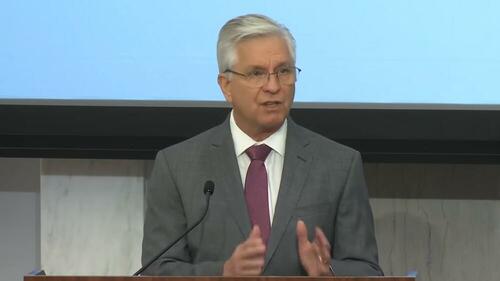
































































































































 Iranian President Masoud Pezeshkian decried the multifaceted Israeli-US-European campaign to weaken and divide the country (NBC photo)
Iranian President Masoud Pezeshkian decried the multifaceted Israeli-US-European campaign to weaken and divide the country (NBC photo) (fizkes/Shutterstock)
(fizkes/Shutterstock) The U.S. Supreme Court in Washington on Nov. 10, 2025. Madalina Kilroy/The Epoch Times
The U.S. Supreme Court in Washington on Nov. 10, 2025. Madalina Kilroy/The Epoch Times


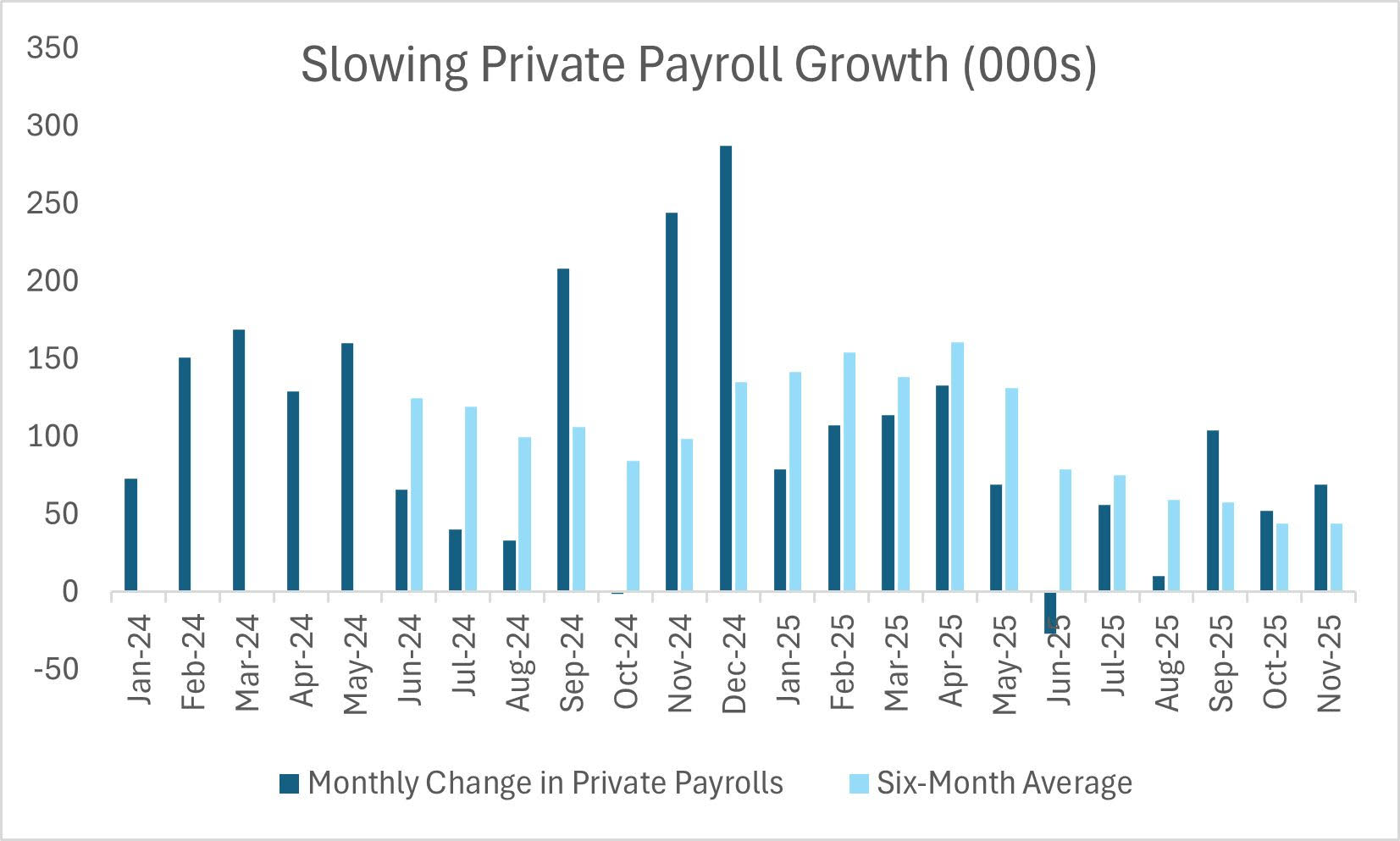
 Anadolu/Getty Images
Anadolu/Getty Images


 Paraguay border police image after Silvinei Vasques caught in country illegally.
Paraguay border police image after Silvinei Vasques caught in country illegally. 

 Most Americans who previously heard of Palau probably did so when it was the setting of Season 10 of the reality-competition show "Survivor"
Most Americans who previously heard of Palau probably did so when it was the setting of Season 10 of the reality-competition show "Survivor" Israeli President Isaac Herzog with Palau's then-UN Ambassador Ilana Seid. Palau is routinely among a tiny group of states that join the US in voting against anti-Israel resolutions
Israeli President Isaac Herzog with Palau's then-UN Ambassador Ilana Seid. Palau is routinely among a tiny group of states that join the US in voting against anti-Israel resolutions Increasing numbers of wealthy Chinese couples are hiring the services of American surrogate mothers to give birth to their babies to circumvent China's one child policy. In the photo, hundreds of Chinese babies accompanied by their parents prepare to take part in a baby swimming contest. STR/Getty Images
Increasing numbers of wealthy Chinese couples are hiring the services of American surrogate mothers to give birth to their babies to circumvent China's one child policy. In the photo, hundreds of Chinese babies accompanied by their parents prepare to take part in a baby swimming contest. STR/Getty Images New FDNY Captain (center) via FDNY
New FDNY Captain (center) via FDNY
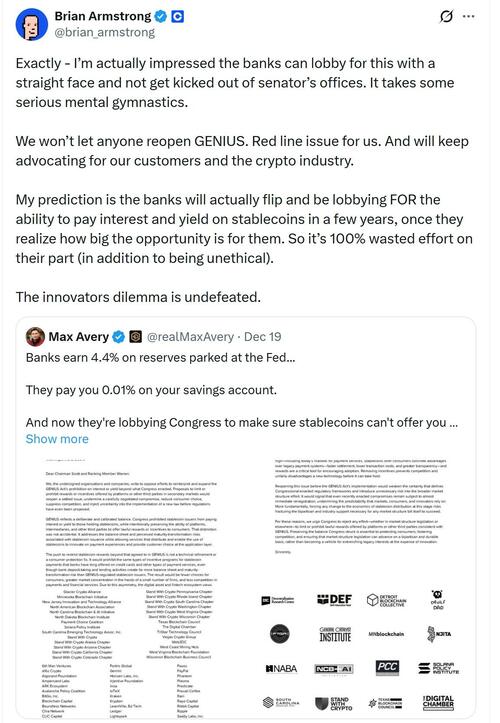
Recent comments